Where to Stay in Amsterdam: Complete Guide for First Timers
Prior to this latest trip, I (Matt here!) had been to Amsterdam multiple times, all for 2-3 days at most, which didn’t leave me much time to really dive into the history and cultural aspects that make the city special. Because every city has a “thing” that makes it unique.
After a longer stay in Amsterdam, I walked away with a much deeper (though still relatively shallow, obviously) understanding of Amsterdam and the Netherlands.
And it’s a FASCINATING place with a great story with highs (the Dutch Golden Age) and lows (World War 2).
Anyway, the point of this little intro is to say that Amsterdam is so much more than the Red Light District and the party reputation that it has been trying to shake for a decade or more.
Amsterdam’s story is one of tolerance, innovation, a touch of rebelliousness, and… windmills (which were essential in Amsterdam’s rise to the most powerful state in the world during the Dutch Golden Age in the 17th Century).
Amsterdam is a magical city, and there’s nothing like walking the canals (particularly in the early morning, when you’ll have them mostly to yourself!) and exploring the unique food scene that has influences from all over the world (for example, Indonesia!) thanks to Amsterdam’s (problematic) history as a colonial power.
In this guide, we’re going to use our experiences exploring the city to do our best to walk you through all the information you need to figure out where to stay in Amsterdam for your particular style, budget, and preferences.
Each neighborhood offers a different blend of vibes, prices, and pros and cons, and we’ll cover it all below so that you’re armed with all the information you need to figure out where to stay for your particular style and budget.
Our intention is that, by the end of this guide, you have everything you need to choose the right place to stay in Amsterdam for you and your travel companions.
Sound good to you? Let’s get into it.
Important note: This is a long guide with lots of detail (it got longer and longer as we put it together), but we’ve done our best to structure it with headings, a helpful summary at the top, and a table of contents to help you navigate it without reading literally every word.
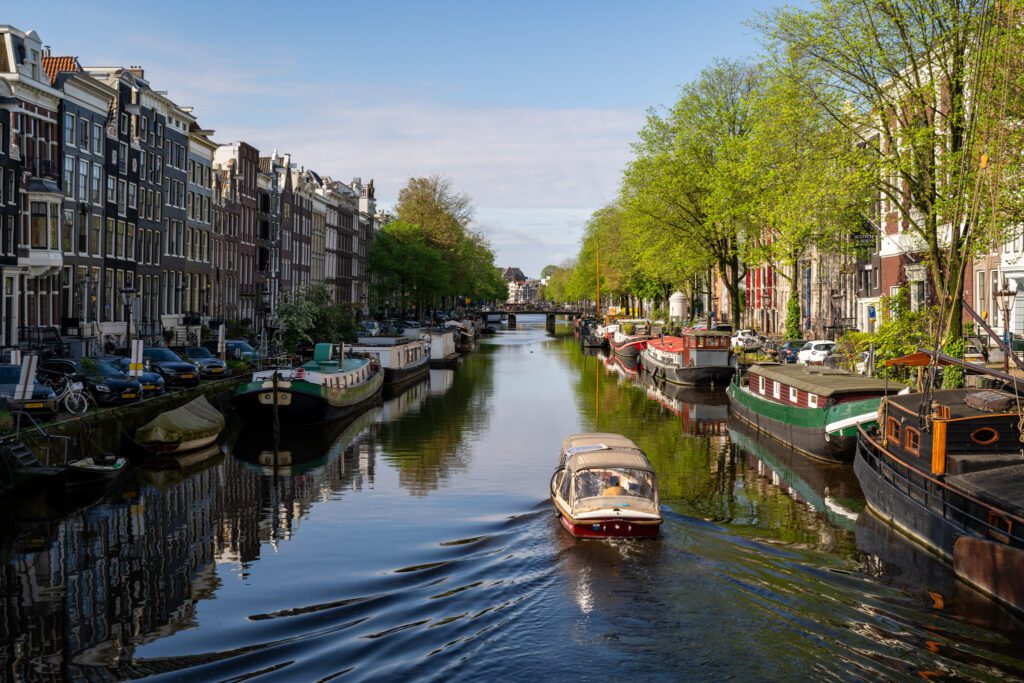
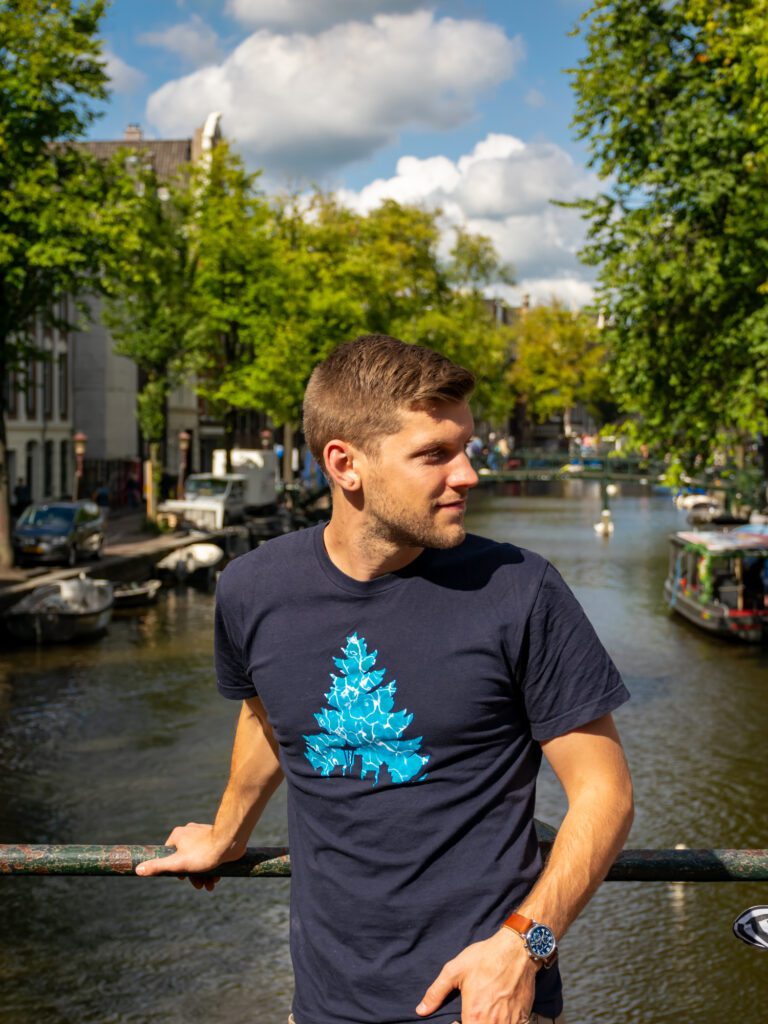
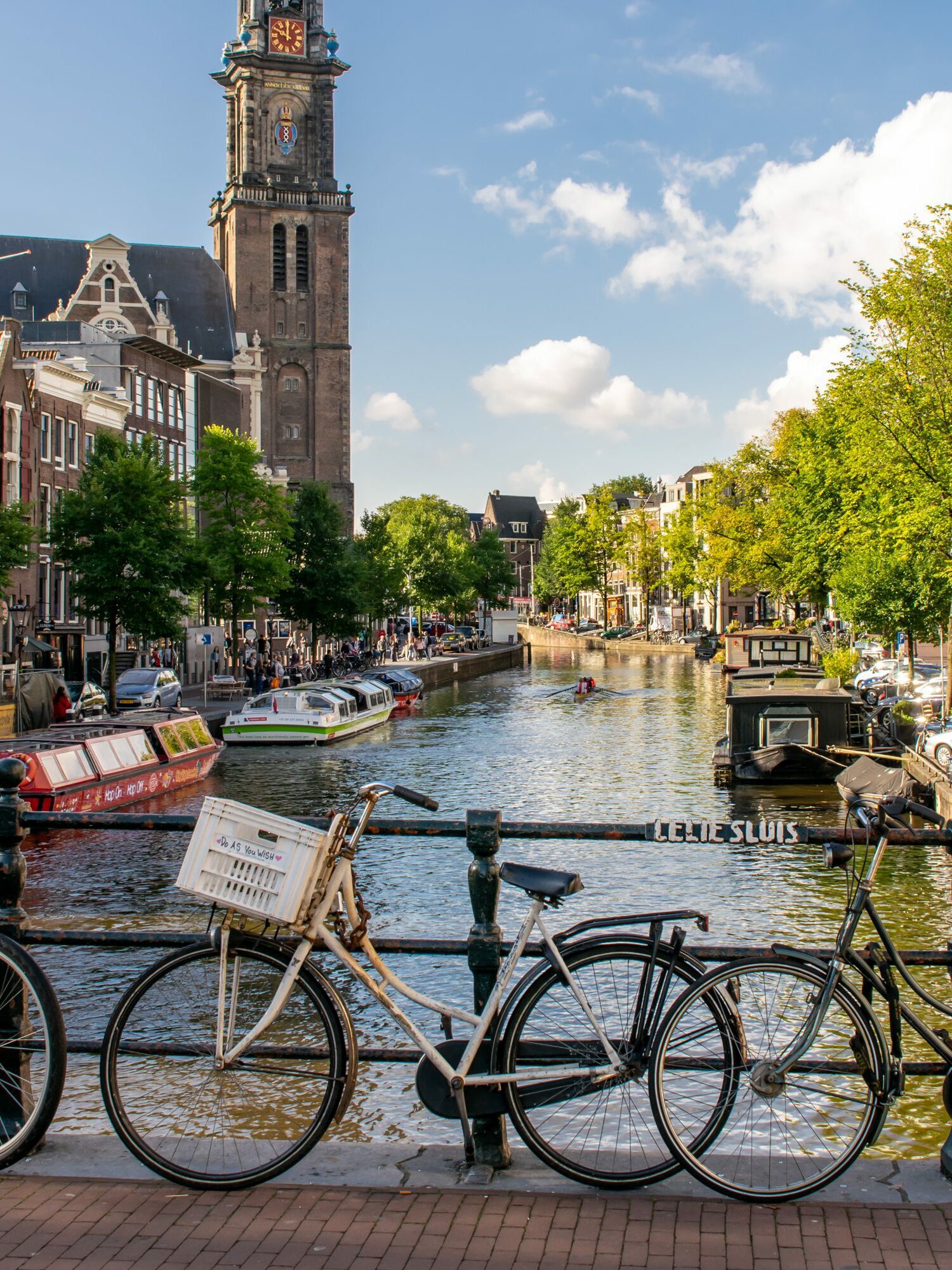
Disclaimer: Some of the links in this post, like hotel links, are affiliate links, meaning at no additional cost to you, we make a little bit of money if you click through and book. That being said, we would never recommend something to you that we don’t stand behind 100%.
Where to Stay in Amsterdam: A Complete Guide
Let’s get right to the main event!
Our philosophy when it comes to deciding on a place to stay is to first choose the neighborhood, then move on to finding a great hotel, hostel, or apartment in that area.
The reality is that, depending on what you’re looking for, there are other neighborhoods not included in this guide that might meet your needs.
But these are the five that we think are the best for 99% of travelers, and we’ve shown our work, doing our best to explain why we think that.
Now, we’re well aware that a few of you are currently ready to throw your left shoe at the screen, saying “I don’t have time to read all of that, JUST TELL ME THE BEST PLACE TO STAY!”
Well, here’s a quick summary of this guide if you’re short on time (though we’d recommend reading the section of the place you end up staying for tips and places to add to your list!).
Our overall recommendation for first timers in Amsterdam is either the Canal Belt (Grachtengordel) or Jordaan.
For us, this is quintessential Amsterdam with leafy streets lining the canals with bars and restaurants with canalside terraces.
It’s magical, especially in the early morning hours (go out on Sunday morning, if you’re around!) and late evening.
In terms of where to stay, we do love the 9 Straatjes (“9 Streets”) area, but there are only a few options and they skew expensive. It gets cheaper as you go further southwest.
For what it’s worth, I originally had booked Morgan & Mees in the Jordaan for a few nights on my last trip, but my plans changed and things no longer lined up.
Instead, we’d personally look towards the Jordaan, specifically at Mr. Jordaan, a charming canalside guesthouse in the heart of the action, or the Linden Hotel, which is a pretty nice value given the amazing location.
If you’re looking for a slightly more affordable and equally convenient area, look at Museumplein. I stayed here for the first few days of my recent trip, and it was easy to get around to every corner of the city (including to and from the airport – take bus 397 and it drops you off right at the square!).
I stayed at Jan Luyken and LOVED it, though it is a little pricier than I usually go for. However, everything – and I do mean everything – is included, which means a good breakfast, drinks (alcoholic and non-alcoholic), and plenty more.
There’s also a Conscious Hotel location on the south side of the square, which is a more affordable option.
If you’re looking for a slice of local life in Amsterdam, stay in either De Pijp or nearby Oost. They’re adjacent neighborhoods that span the whole east side of the half onion that is central Amsterdam.
Full disclosure: I LOVE De Pijp, and fell in love with Oost over my weeklong stay there on my latest trip.
It’s more residential and dense than the Canal Belt, and both neighborhoods are full of great places to eat and drink.
In De Pijp, stay at the Pestana Amsterdam Riverside (which is on the southeastern end of De Pijp along the Amstel River) or the CitizenM Amstel (we LOVE CitizenM and have stayed at four of their hotels around the world).
If you’re on a tight budget, look east or west of the main center in Oost or Oud-West, which generally offer more value for your money at the price of time spent getting to and from places you’re going.
Look at the Conscious Hotel on Westerpark, a mid-range option in a nice setting (it’s literally inside the park, which is fun) or the Social Hub (we’ve stayed at the Social Hub in Bologna, and it’s somewhere between a boutique hotel and a nice hostel).
Heading further south to Zuideramstel is another good budget-friendly option, particularly this Motel One location.
The city gets far more residential, and there’s a nice cluster of hotels with relatively easy transit connections to the center (15-20 minutes on a tram).
Here’s a map to help you visualize what we’re talking about.
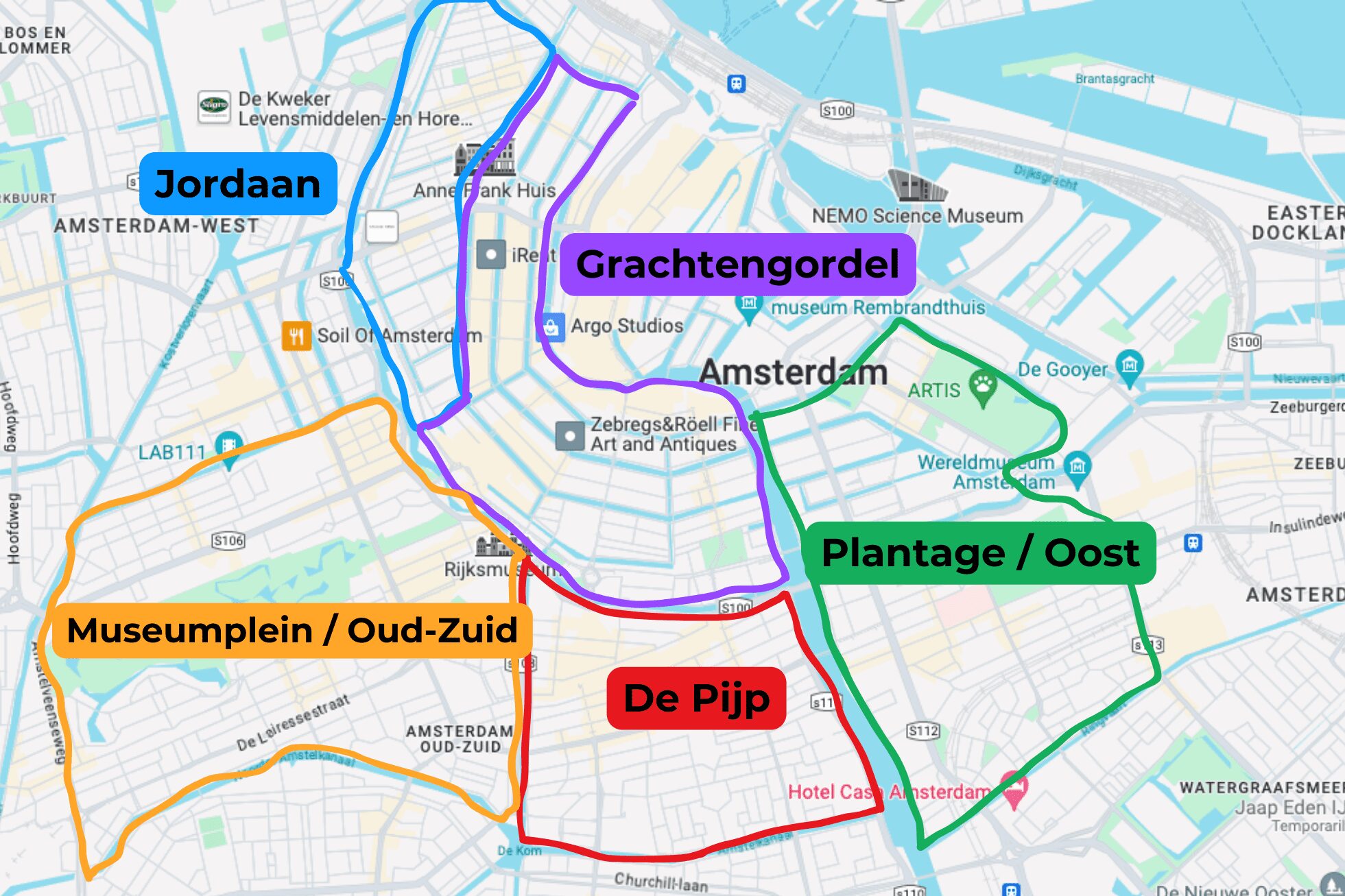
It’s absolutely worth noting here at the top that, because of their ongoing housing crisis, Airbnb as we know it in the U.S. is essentially illegal in Amsterdam, which is why you won’t find many options if you search for them.
I chatted with multiple locals about this, and the idea that they all circled around is that housing (like apartments that you’d find on Airbnb) should be for residents, not profit, and the laws around Airbnb in Amsterdam reflect that.
Basically, you need an expensive permit (which are now heavily regulated and restricted) to offer a vacation rental, it must be your main residence, and you can only rent out an entire home for a maximum of 30 days per year.
Those regulations are why you generally find private rooms in Amsterdam, which have less stringent regulations (they’re considered a bed and breakfast) and while there are entire homes available, the majority of them are sketchy (at best).
I actually met two different groups who had their Airbnb canceled last minute (one on their flight to Amsterdam).
If you’re looking for an apartment with more space and a kitchen, look at aparthotels, which offer the same amenities (and zoning, crucially) as hotels, like a front desk and baggage storage, but the rooms are apartments.
For what it’s worth, that’s our favorite way to travel these days, and there are some good ones in Amsterdam (I stayed at Wittenberg by Cove – which has a seven day minimum – and there’s also Zoku Amsterdam a few blocks away which I also considered).
We’d avoid staying is the stretch of the city between Dam Square and Central Station. It’s all multinational chains and unbelievable traffic, and the area immediately adjacent to the train station isn’t particularly charming or nice.
One note on the Red Light District: Known as “De Wallen” in Dutch, this is one of the oldest parts of the city. But it is somewhere we would never recommend staying because it is the epicenter of Amsterdam’s reputation for being one big party (which, for the record, we don’t think is particularly warranted at this point).
Where We’ve Stayed in Amsterdam
As usual, we like to start these guides with our own experiences, and in this case, that means covering the places we’ve stayed in Amsterdam that we’d recommend.
We’re going to completely exclude our previous trips to Amsterdam because they were so long ago, and the city has changed significantly since then.
Instead, we’ll focus exclusively on this past trip in the spring of when I (Matt here!) spent about two weeks in Amsterdam sandwiched around a broader trip to Europe, and I stayed in two different places over that period.
For my first stint in Amsterdam, I decided to stay as centrally as possible to make the most of my three days exploring.
I landed on Museumplein (the Museum Quarter near the Rijksmuseum and the Van Gogh Museum), which turned out to be a perfect location for a short trip.
It’s within walking distance of the canal ring, De Pijp, and the museums, and it has excellent tram connections to the rest of the city.
I stayed at Jan Luyken, a brand new guesthouse one block from the museums, and I was enamored by the model they use. .
Instead of nickel-and-diming you for every little thing in the hotel, literally everything is included. Coffee and breakfast in the morning? Included. Happy hour wine and cheese? Included.
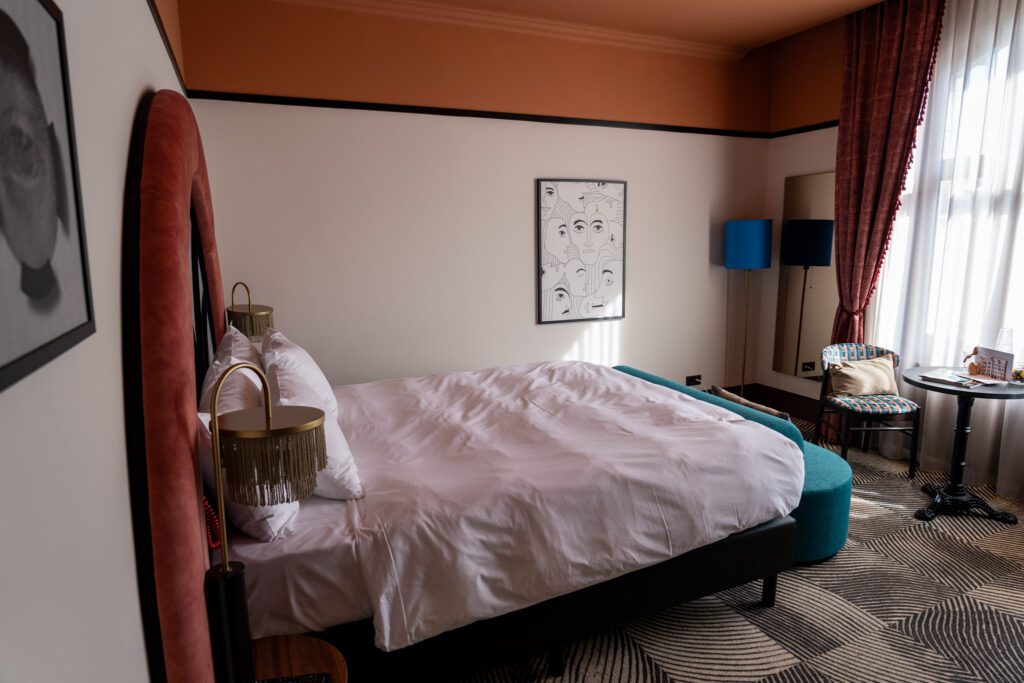
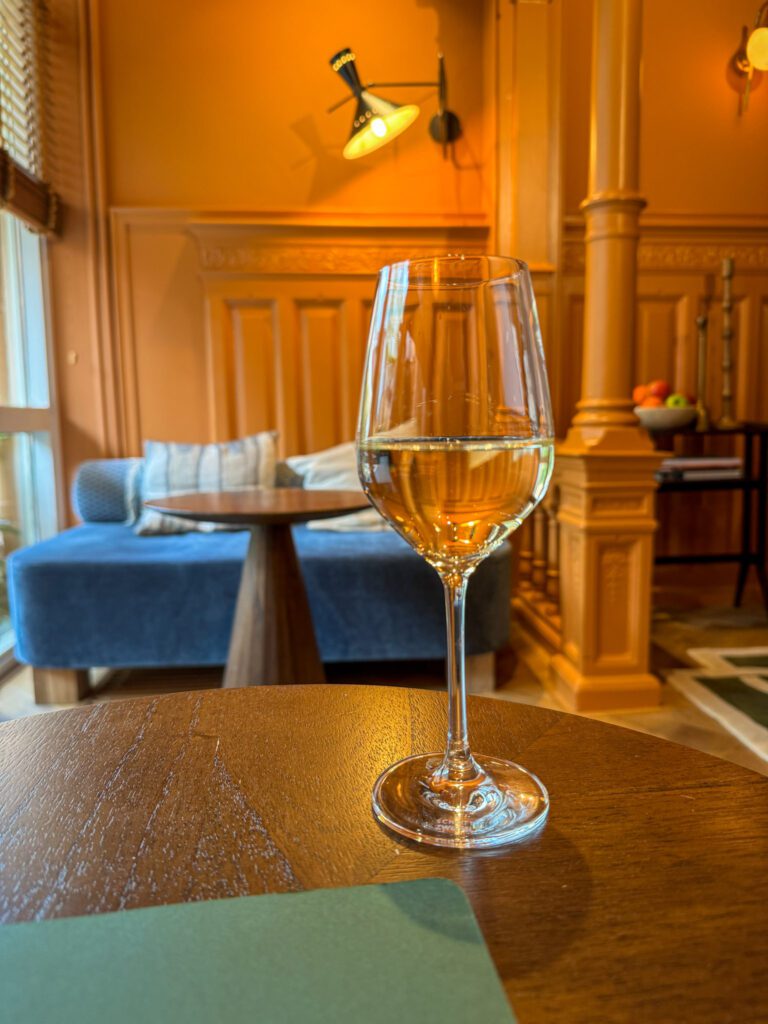
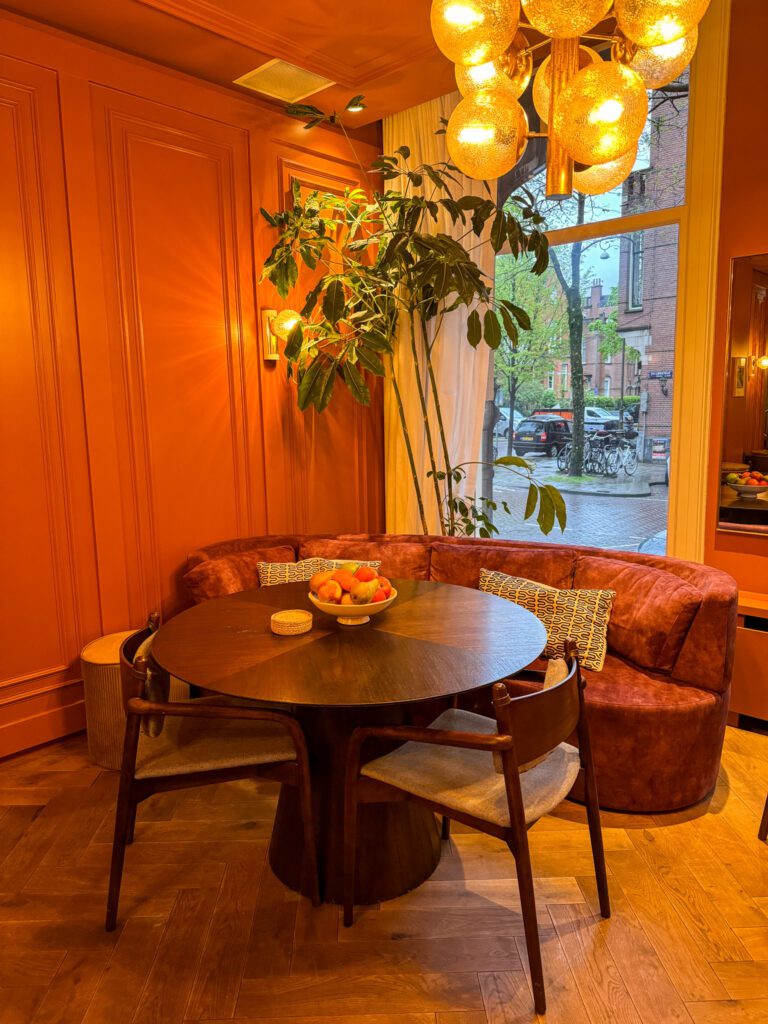
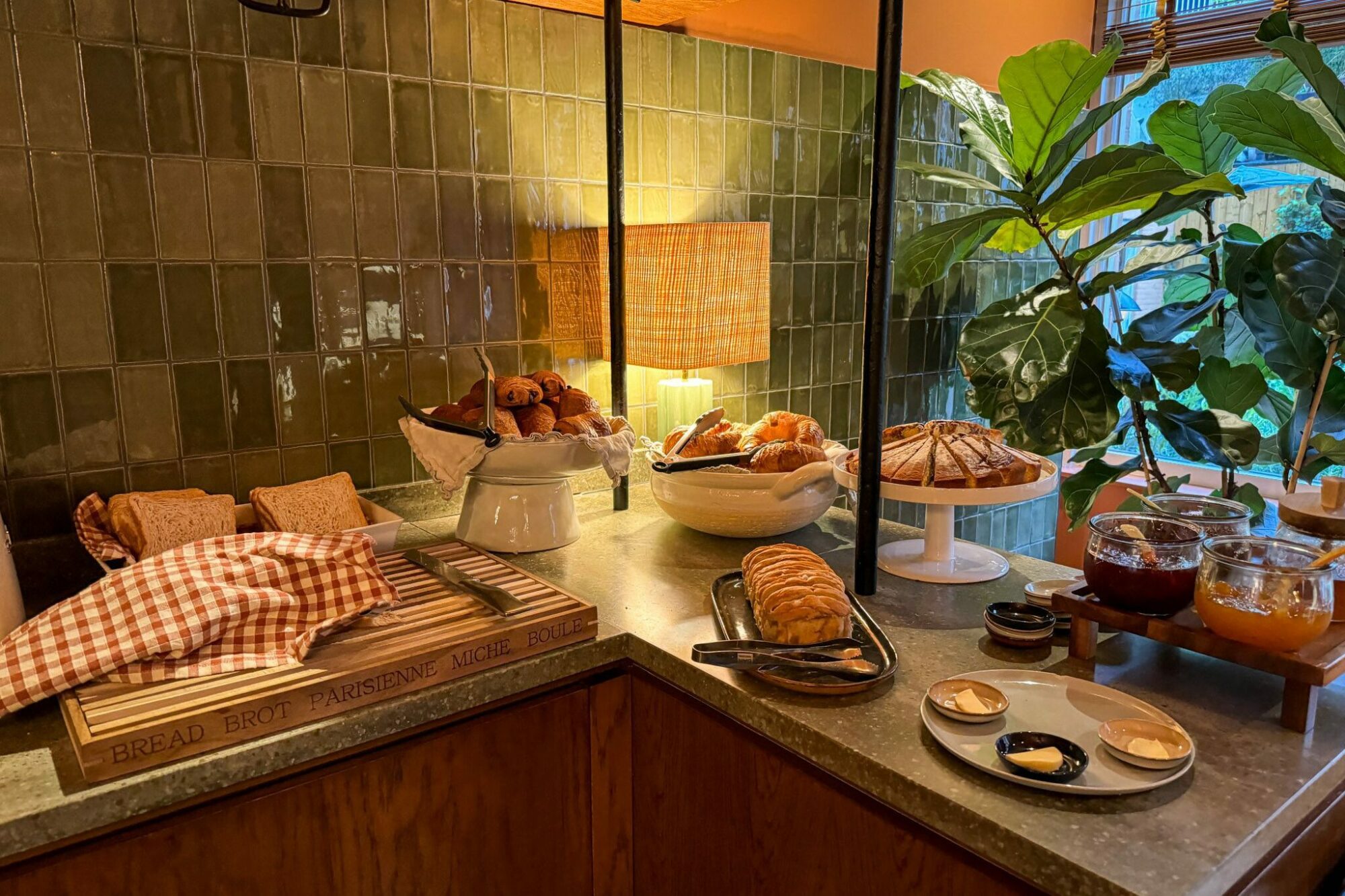
I really liked it – it’s an old building with charm and character, but it has been renovated and designed immaculately.
The staff were also a highlight of my stay – they’re young, friendly, and were always happy to help with anything I had questions about (including trying to learn Dutch).
For my second stint in Amsterdam, I had seven days and wanted a little more space, so I started looking for a nice aparthotel in Amsterdam (I was doing this mid-trip because I realized that I was going to have trouble living out of a hotel room for a full week).
As I began looking, I pretty quickly narrowed down the list to three places: Wittenberg by Cove (I’ve stayed at a Cove property in London before and loved it), Zoku Amsterdam, and The July by Boat & Co.
Zoku and Wittenberg are within a few blocks of each other in Oost, a part of the city I was interested in exploring, so I narrowed it down to those two.
I chose Wittenberg by Cove because of my previous experience with them, and I’m glad I did.
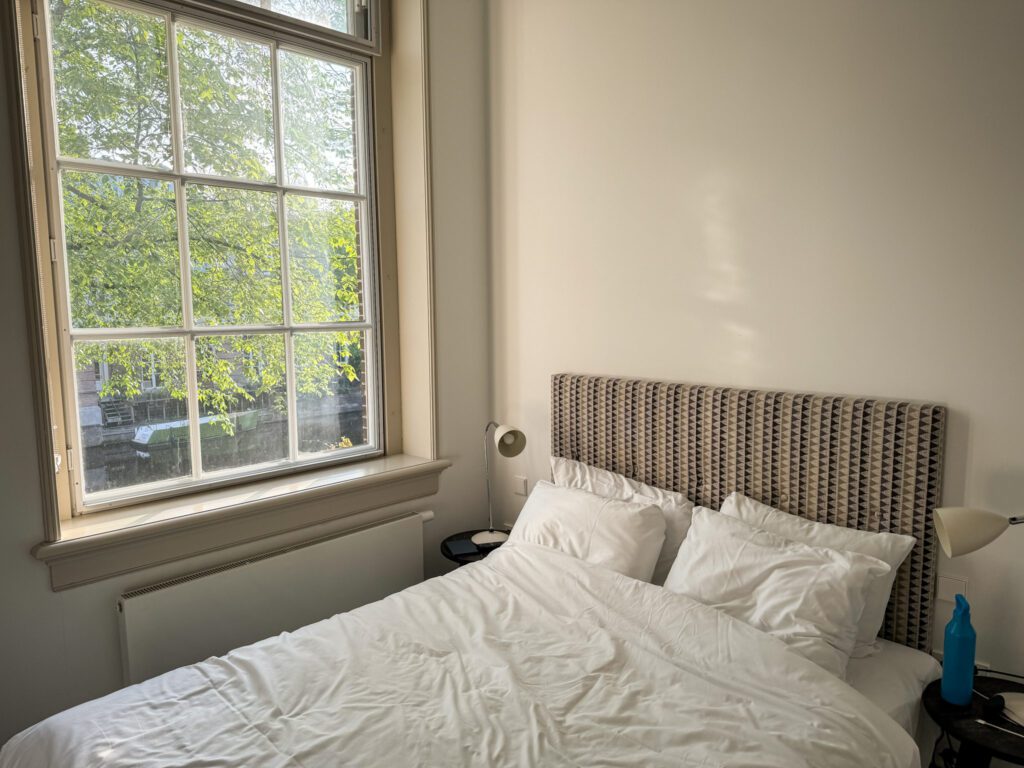
They have a seven day minimum – which is the main reason I’d choose Zoku if you are in town for fewer than seven days – but the apartment was spacious, comfortable, and had everything I needed for a week of exploring Amsterdam.
I also really liked this part of the city, which is more residential (but still beautiful with canals) and lively thanks to the University in the neighborhood.
The Jordaan: A Hip Neighborhood in a Great Location
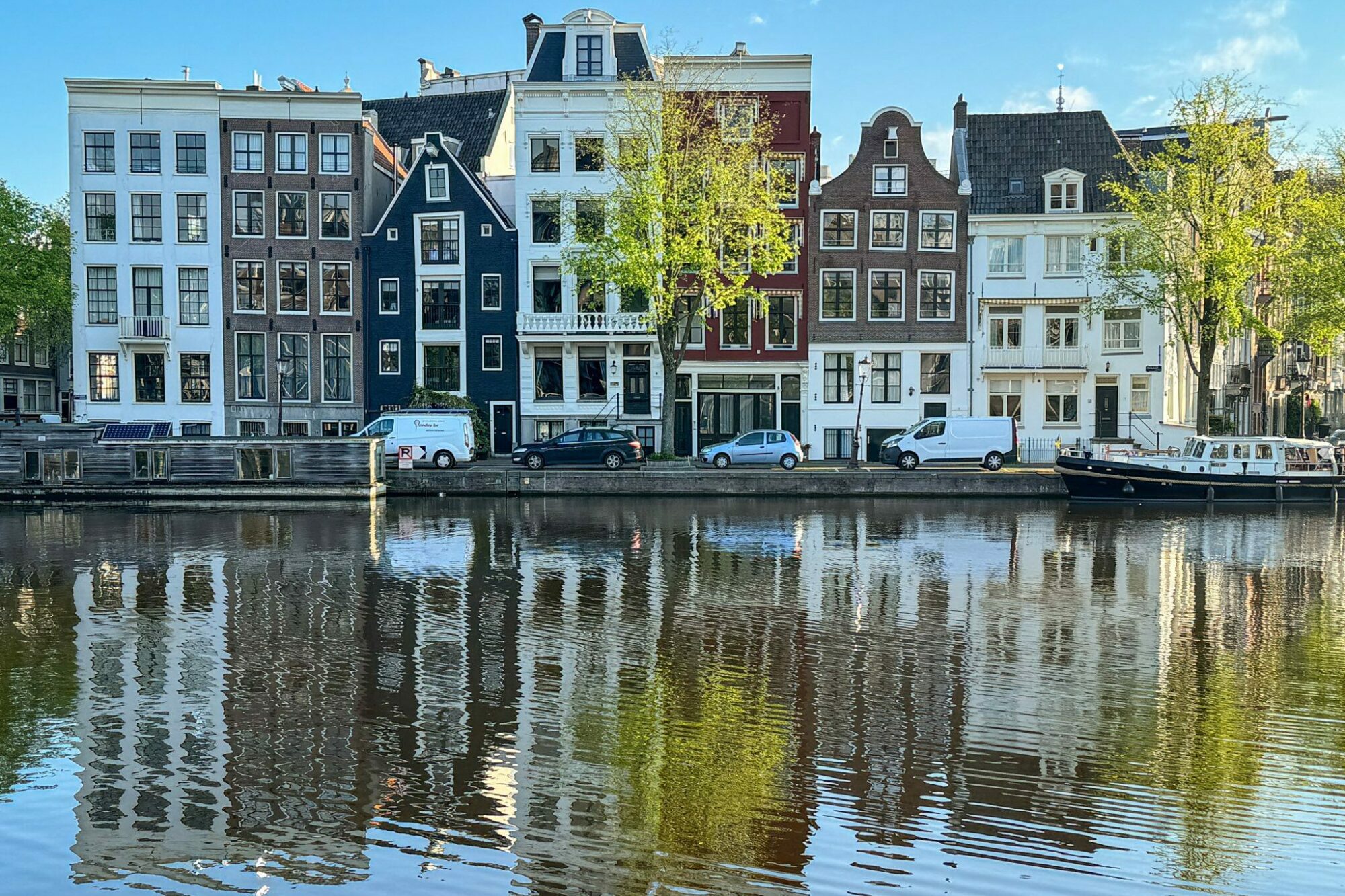
While the Canal Belt is where the rich people settled, they quickly came to the realization that they were going to need a place for all the workers they needed to maintain their easy lives to live.
Enter the Jordaan. It’s close to the rich people’s houses, but it was very much a working class neighborhood until very recently.
It’s on the outside of the belt of three canals that were added to the city during the Golden Age, and it’s more dense and the houses are far (FAR) less ornate than the houses on the prized property along those three main canals.
As you’re walking along the narrow streets in the Jordaan, it’s easy to imagine the tough living conditions before this area was developed and fixed up.
During the mid 20th Century, this area was one of the poorest neighborhoods in the city, and conditions here were dire in terms of sanitation and cleanliness. Which is hard to believe walking through the area now.
However, like many former working class neighborhoods around the world, a funny thing happened with the Jordaan over the past 20 years or so.
First came the artists and students, who moved there for the cheap housing.
Then came the businesses catering to (or opened by) the artists and students.
Then came the hipsters, looking for the next cool thing.
And, finally, the yuppies arrived. And now it’s one of the most expensive and desirable neighborhoods in the city.
The Jordaan still has those working class roots, and though many of the businesses in the neighborhood have been there for decades, it has gone through a transformation over the past few decades that places like Brooklyn and the Mission in San Francisco have also experienced.
Gentrification.
Still, it’s a nice place to be in the modern day, and while there aren’t very many hotel options here, there are some gems that will put you right in the middle of all the action (and within walking distance of both Amsterdam Centraal Station and the Anne Frank House).
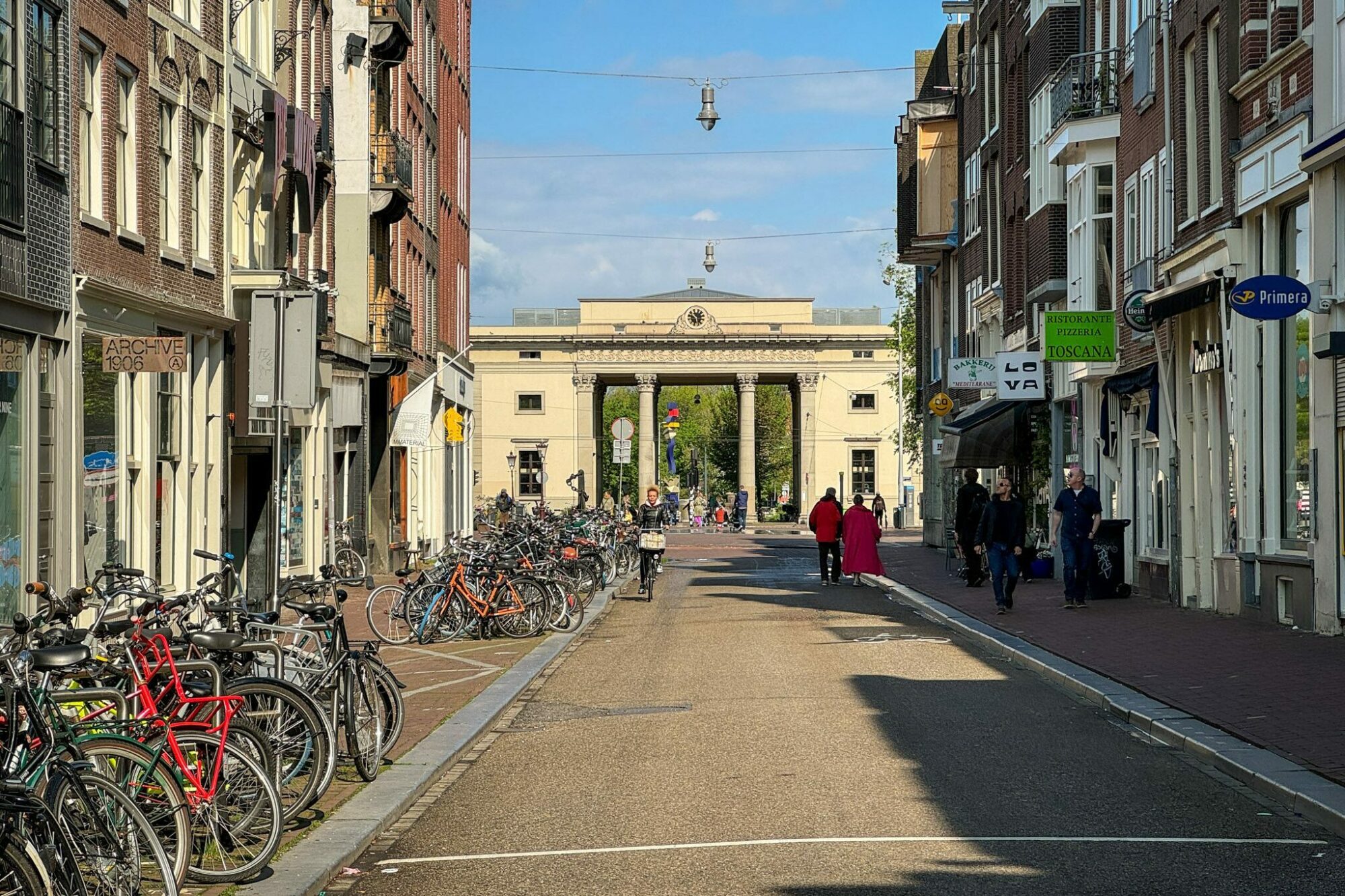
Pros and Cons of Staying in the Jordaan
Here are the pros and cons of staying in the Jordaan, according to… well, us.
Pros of Staying in the Jordaan
It’s charming. Narrow cobblestone streets, canal views, and corner cafes make this an exceedingly pleasant place to hang out.
It’s full of good food and drinks. Some of Amsterdam’s best places to eat – including the consensus two best apple pies in Amsterdam – are in the Jordaan. You’ll find a couple of our favorites – including an esteemed brown cafe and a historic pub – in the “highlights” section below.
It’s walkable. You’ll be within a short walk of the Anne Frank House, Centraal Station, and multiple tram lines.
Cons of Staying in the Jordaan
Not many choices. There’s really only a couple of hotels in this area, mostly because Amsterdam’s center had been declared a UNESCO World Heritage site by the time development would have had to happen here (nobody wanted to develop it in the 1980’s) and that means you can’t change the facade of the buildings here.
It’s expensive. Between the fact that it’s desirable and the fact that there are very few options, it should come as no surprise that the next line here is that it’s expensive.
It’s gentrifying (gentrified?). It’s hard to call this area “gentrifying” because, to me, it feels like it has gone all the way through the gentrification process.
Still, there are remnants of the working class neighborhood that existed here a few decades ago, which are a surprise and delight as you’re walking the streets.
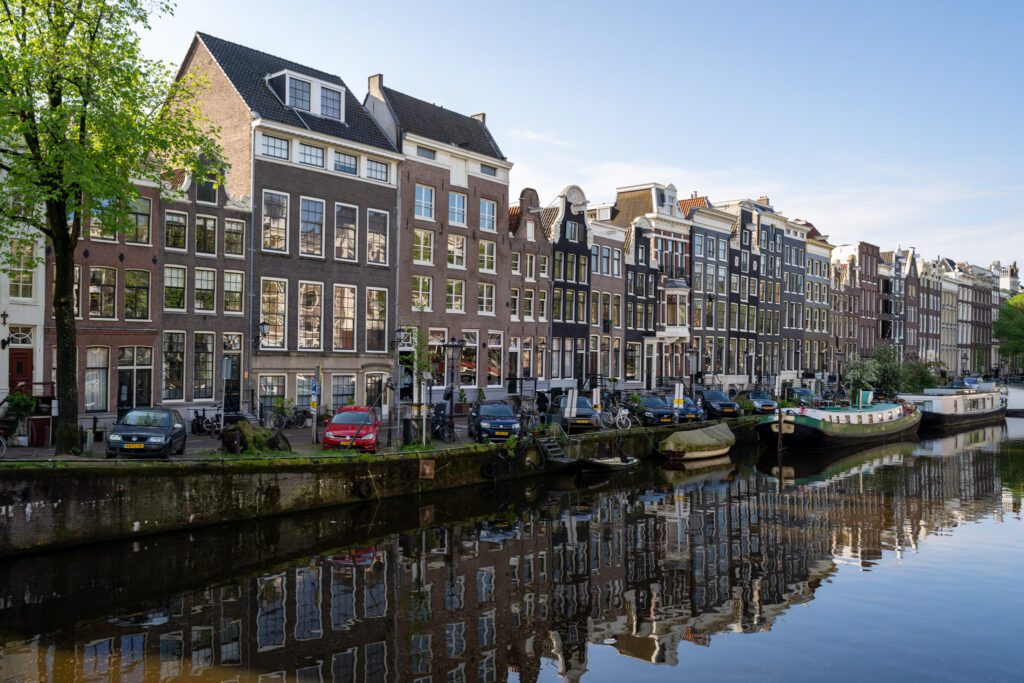
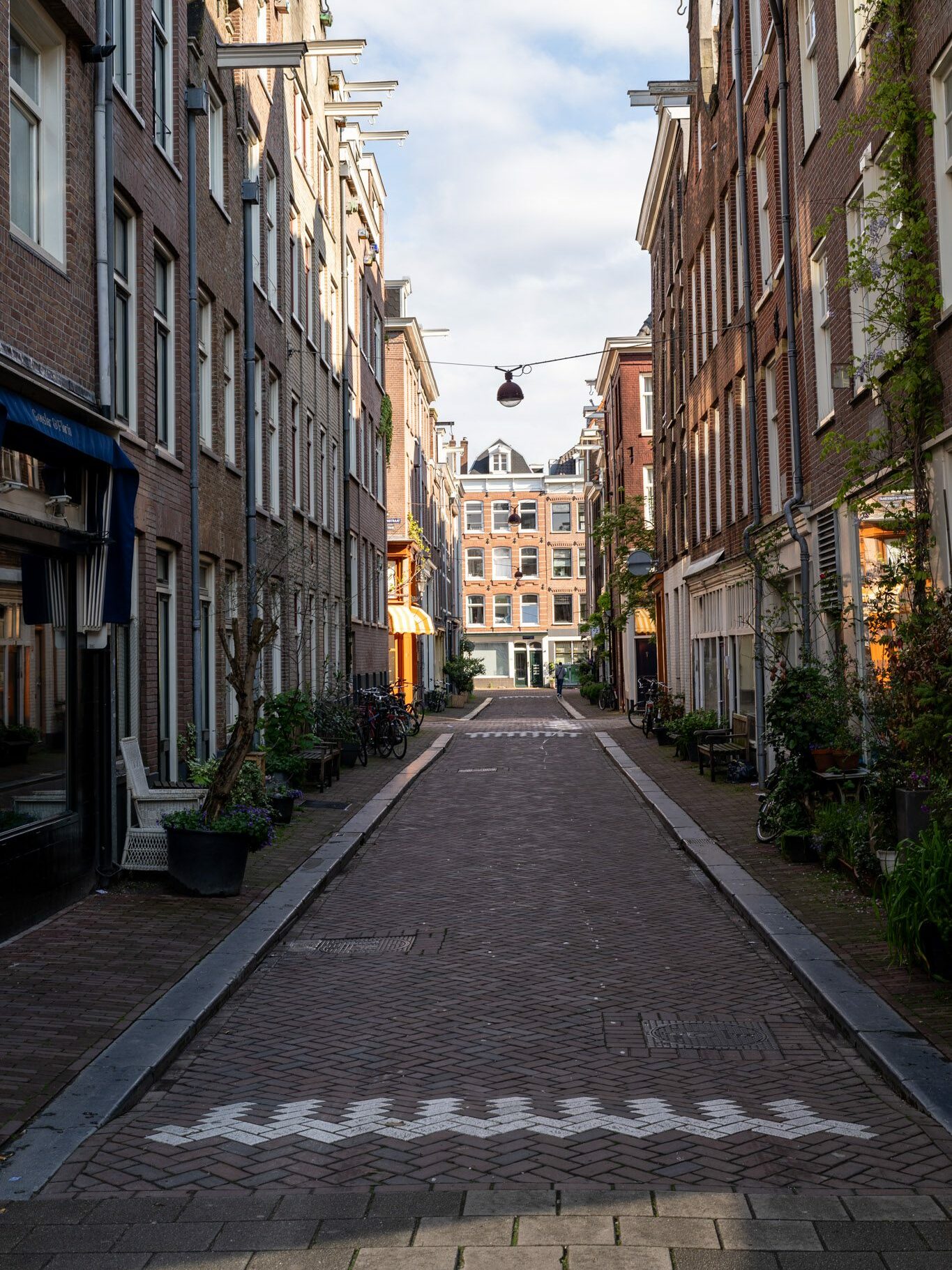

The Best Places to Stay in the Jordaan
Here are a few places in the Jordaan that caught our eye.
Morgan & Mees: A Cool Boutique Hotel in a Great Location
This boutique hotel is at the top of our list of the coolest hotels in Amsterdam. It’s right on the border between the Jordaan and Westerpark, which means the location is basically perfect.
I actually had a few nights booked here to close out my latest trip to Amsterdam, but decided I wanted to have a little more space to do some writing, and ended up moving to an aparthotel instead.
It is a few blocks away from the Anne Frank Museum, so you’re right in the middle of all the action, and the style is right up our alley.
It’s set in a cool brick building, and has a restaurant with huge windows and plenty of light on the ground floor.
The rooms themselves are relatively spacious, especially for Amsterdam. It’s a little funny to us that their lowest level room is still a “deluxe” room, but we’re going to look past that.
They have “deluxe” double rooms that are spacious and full of natural light, suites that are downright gigantic with separate living areas and balconies, and split level rooms that, while relatively small, feel bigger because the bedroom is on a separate floor. Each room has a mini fridge and coffee machine.
Mr. Jordaan: The Coolest Guesthouse in the Neighborhood
Mr. Jordaan is a charming guesthouse in the heart of Jordaan that has been around since the 60’s, consistently expanding as more and more travelers have experienced their hospitality.
As far as rooms go, they have a variety of sizes and configurations, from single rooms to accommodate solo travelers, to triple rooms for a family or group of friends.
They have free tea and coffee in the lobby (along with a kettle and tea/coffee in the rooms), along with a nice collection of books that is also free to peruse (but don’t take them home with you!).
Perhaps the best amenity they have is a set of OV cards – which are good for using public transit like a local – that you can borrow and load up so that you don’t have to buy a ticket from the driver every time you hop on.
The Blossom House: A Cozy Guesthouse in the Heart of Jordaan
This small, cozy guesthouse only has two rooms, but they’re about as stylish as they come.
Set inside a building with a 17th Century facade, the rooms have been renovated and redesigned to bring them firmly into the 21st Century, with industrial-chic light fixtures, subway tile in the bathroom, along with some nice modern touches like heated floors!
They have two rooms – the double room, and the deluxe double room, which is almost twice as big and has more of a seating area and room to spread out and relax.
Both room types have mini fridges, water kettles, and Nespresso machines.
The location on Bloemstraat is a block from Prinsengracht, one of the more picturesque canals in the city, and is right in the heart of Jordaan, just minutes away from bars, restaurants, coffee shops, and shopping in the Nine Streets area.
Linden Hotel: A Good Mid-Range Option in Jordaan
Tucked away at the northwest corner of Jordaan, the Linden Hotel is a solid value in a city of, well, pretty expensive hotels.
Rooms are modern, stylish, and cozy – no huge suites here – but have everything you’ll need to get a good night’s sleep after a day spent exploring Amsterdam.
After all, if you’re spending most of your day inside your room, you’re kind of doing the whole traveling thing wrong, aren’t you?
We like that they’ve leaned into the whole “tiny” theme – the first thing you read on the frontpage of their website is “Where everything is tiny: tiny cafes, tiny shops, tiny restaurants and tiny gardens. You’ll feel the cosiness of tiny everywhere you go”.
While rooms are on the small side, the upside of that is that so are prices – particularly in the shoulder seasons and in low season, when you can find rooms under 100 Euros a night (prices rise in summer, as they always do).
Breakfast is available (15 Euros a person), and there’s free coffee and tea in the lobby for those times you need a quick pick-me-up before hitting the streets of Amsterdam.
Grachtengordel / De 9 Straatjes: Our Favorite Part of Amsterdam
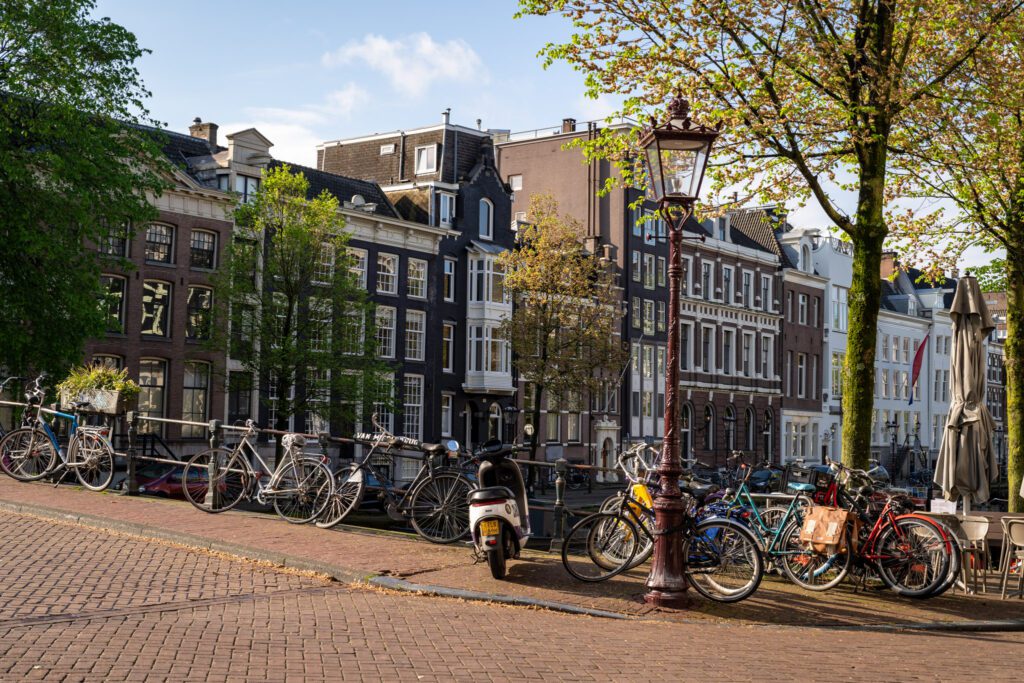
This is absolutely our favorite part of Amsterdam, and we should probably take a second to talk about the geography and difference between the two neighborhoods we’ve smooshed into one category here.
At a high level, Grachtengordel is the ring of canals that forms the half onion in central Amsterdam, and De 9 Straatjes (“Nine Streets”) is a very small piece of that broader neighborhood that refers to a block of three by three streets in the center of the Canal Belt.
The broader neighborhood refers to the canals that were built in the 17th Century as an expansion to the old town (which is basically the area near the Red Light District and Dam Square today).
Specifically, Grachtengordel refers to those four canals that run from the RiverIJ on the north side of the city center (the river behind Centraal Station) in a counter-clockwise ring around the city to meet the Amstel River.
Broadly speaking, the most romantic and charming piece of the neighborhood is the area on the northwest side of the city center, closest to Centraal Station and the Jordaan.
As you move south and east, this neighborhood gets a little less charming, but the plus side is that you’ll find more places to stay (especially in the area smushed between Museumplein, De Pijp, and Centrum).
The biggest challenge here is going to be the relative lack of hotels in this section of the city. It was declared a UNESCO World Heritage site in 2010, so it’s very difficult to make updates and expansions of the historic buildings here.
As a result, any hotels here have to essentially keep the existing footprint and facade, which makes development difficult.
All the charm and the central location is going to come at a price, but if you’re looking for a special experience, you can’t go wrong staying here (many of the best hotels in Amsterdam are in this part of the city).
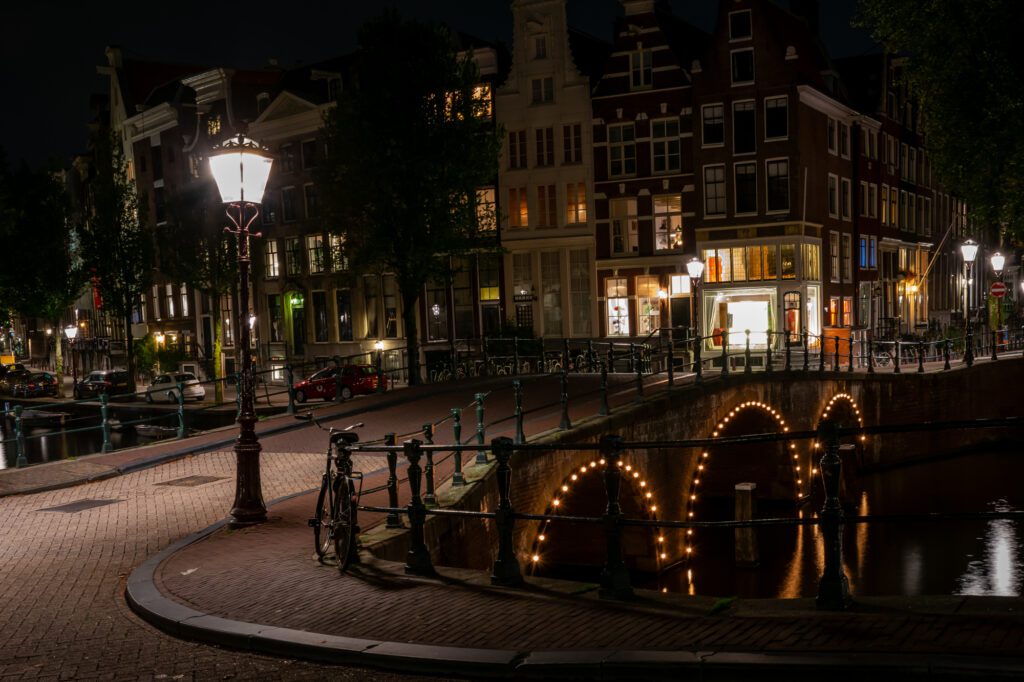
Pros and Cons of Staying Along the Canals
Here are the pros and cons of staying along the canals as we see them.
Pros of Staying Along the Canals
It’s charming AF. There’s nothing better in Amsterdam than walking along the canals in the early morning or late evening, which you’ll be in the perfect position to do as many times as possible if you stay here.
Tons of places to eat and drink. From historic brown cafes to trendy vegan bakeries (and just about everything in between), there’s a ton to eat and drink in this neighborhood. You can find our suggestions in the “highlights” section below.
Cons of Staying Along the Canals
It’s wildly expensive. In combination with the next bullet, the biggest issue of this neighborhood is going to be the lack of places to stay, especially in the 9 Straatjes area and the rest of the part of the neighborhood that is closest to the train station.
There aren’t many choices. As we just mentioned, there’s only a couple of hotels in this part of the city, and they tend to be the higher end luxury hotels.
It makes sense because in this whole area, it is nearly impossible to expand and renovate existing buildings due to the UNESCO World Heritage status.
It isn’t particularly quiet. Especially in the middle of the day, this neighborhood is going to be extremely busy.
Which is why we believe that staying here is a good way to experience the city without the throngs of people because you’ll be able to walk right out your front door in the early morning and late evening and have the canals (mostly) to yourself.
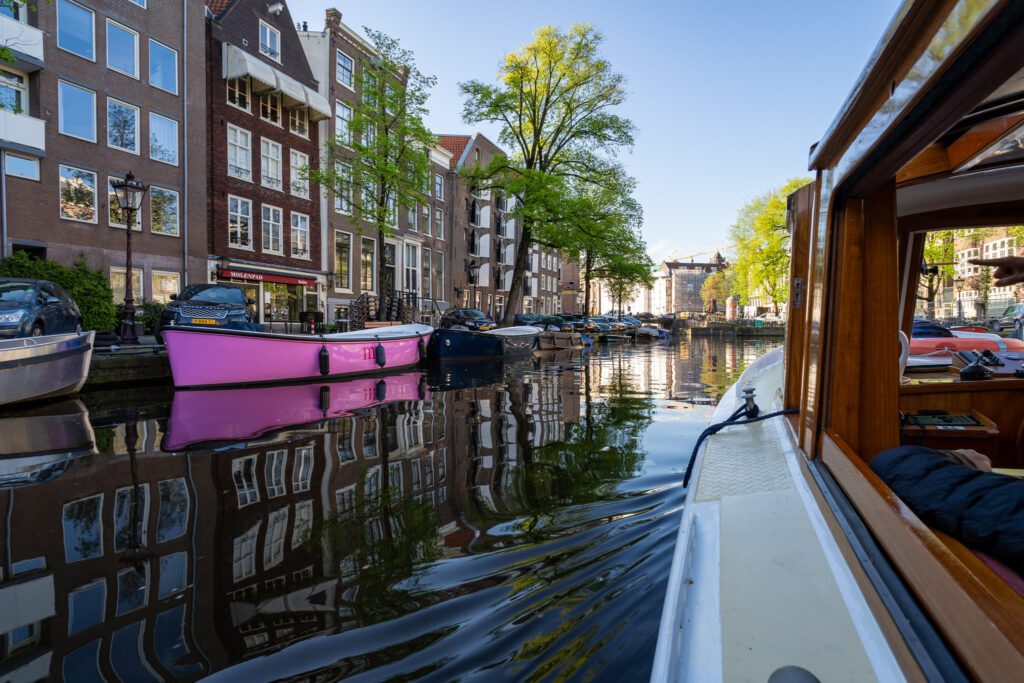

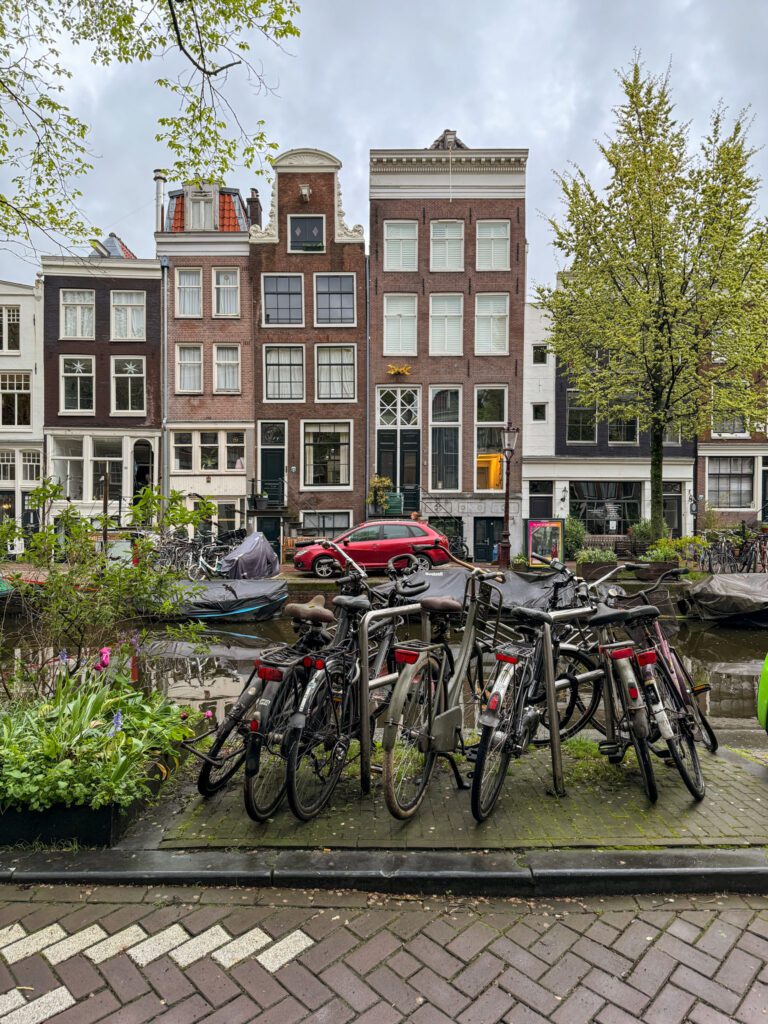
The Best Places to Stay in the Canal Belt
Here are some cool hotels in the neighborhood that caught our eye. A reminder that, in this part of the city, you’re looking at a very limited (and therefore, very expensive) collection of hotels and guesthouses.
Hotel IX Streets: Modern Mid-Range Hotel in a Great Location
This brand new boutique hotel in Amsterdam is in a restored 17th Century building that has been renovated, top to bottom, to create a modern oasis for your stay in Amsterdam.
It’s a small building with just five rooms, and they have a completely contactless check-in system, which might be a pro or a con, depending on your particular preferences (we’re on board with contactless, for what it’s worth).
There’s no onsite restaurant, bar, or cafe, but there is a nice selection of those things within a few blocks, so it doesn’t really matter too much.
Each room – or “suite” as they call them – comes with a Nespresso machine and tea kettle, plus a stocked mini bar (that is free!).
You’ll be in the heart of the Nine Streets, and the Royal Palace is a few blocks east.
‘t Hotel: Family Run Hotel In the Center of Everything
This relatively small family-run hotel (eight rooms) is at the northern end of the Grachtengordel right on Leliegracht, which is a short walk from Dam Square, the Anne Frank House, and the Jordaan.
The location is pretty unbeatable, we think, and you’ll be able to walk almost everywhere.
The hotel itself is in a historic building that dates back to the 17th Century (but has been renovated beautifully on the inside, which took place in 2014).
Each room is unique in terms of decoration, and they are all named after famous canals that run through the city (e.g. Singel, Prinsengracht, etc). However, it’s worth noting that only a few of the rooms have canal views (and those are going to be slightly more expensive).
It’s also worth noting that they have a room that is perfect for families, with a queen bed and two single beds in a loft. However, there’s only one of that particular room type, so book it early!
Breakfast is included in the room rate, and you’ll enjoy it on the ground floor before you head out for the day.
The Hoxton: One of the Coolest Hotels in Amsterdam
The Hoxton is as stylish as it gets, and the location is perfect. You’ll be right in the middle of all the action, in a super central area between the Anne Frank House and the Red Light District.
It’s right on the Herengracht, one of the most famous canals in the city.
It also happens to be a surprisingly good value given the location and amenities, though it’s by no means the cheapest hotel in Amsterdam.
The Hoxton is one of our favorite boutique hotel chains, catering to people who crave style, simplicity, and authenticity, which is right up our alley.
Every time you walk into a Hoxton Hotel, it feels like a natural extension of the neighborhood it’s in, which is a perfect way to immerse yourself in the place you’re visiting.
They have a variety of room types and sizes, from their “cosy” rooms (180 sq. ft.) to their “biggy” rooms (300+ sq. ft.), and some have canal views.
They also have an onsite restaurant – Lotti’s – that operates as an all-day spot for coffee, cocktails, and bites.
Museumplein: A Great Location at a More Reasonable Price Point
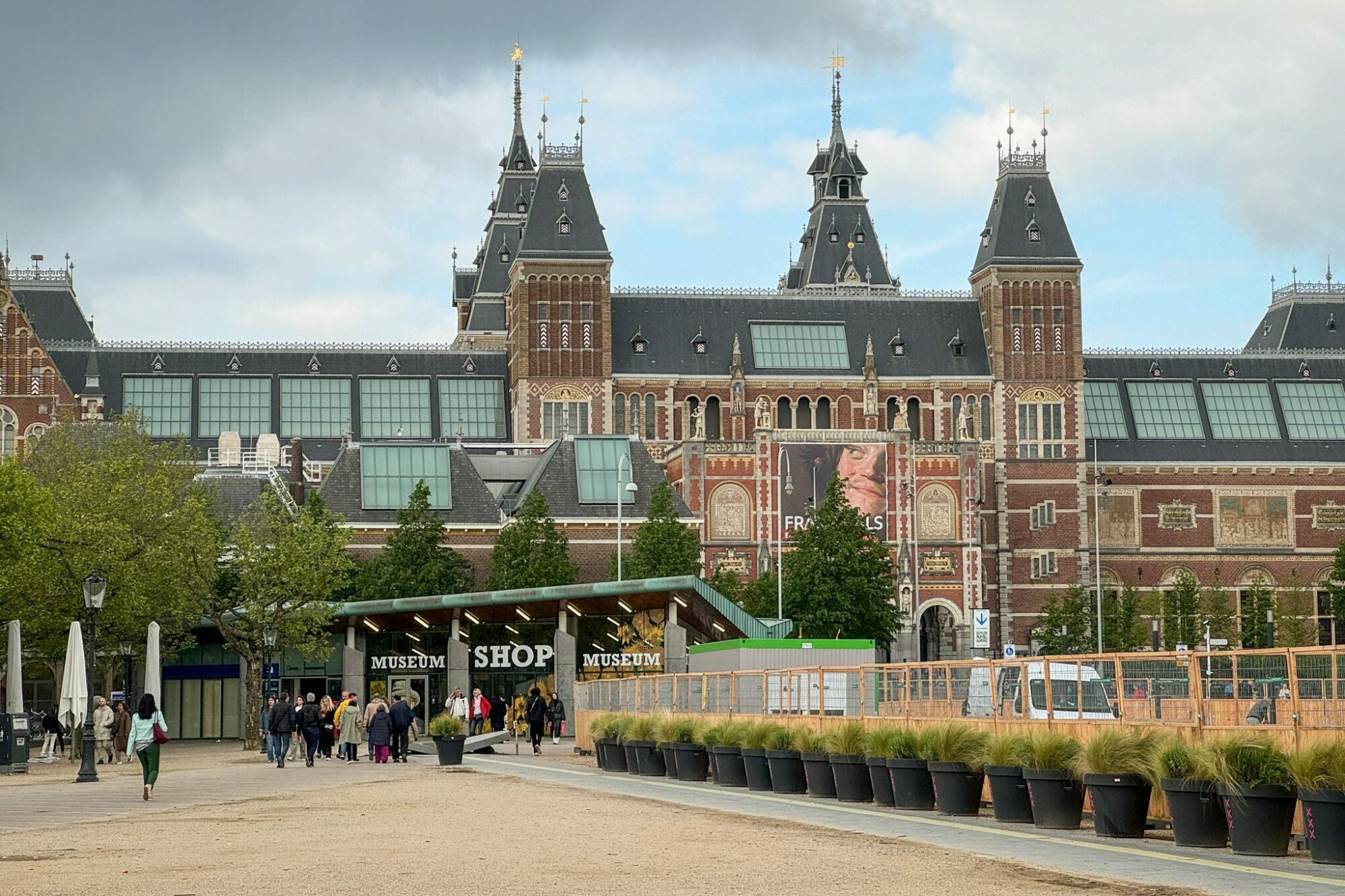
On my last trip to Amsterdam, which was a 10 day stint split into two parts that bookended a broader European adventure, I spent my first few days staying near Museumplein because I found it to be as central as it gets and I wanted to make the most of my first few days.
I don’t think I quite appreciated just HOW good a location this would be for getting around to other parts of the city.
From the Museumplein, there are trams running in all directions that will whisk you away to places like Amsterdam Centraal and Dam Square within 15 minutes.
Plus, there is a bus from the airport (bus 397) that will take you from the arrivals hall to Museumplein in roughly 15-20 minutes, depending on traffic.
If you’re looking for a central location but don’t want to shell out the extra money to stay right on the canals, this is a great option. It’s not the cheapest part of the city (though it is cheaper than the Grachtengordel or the Jordaan), but the central location will be very useful for exploring the city.
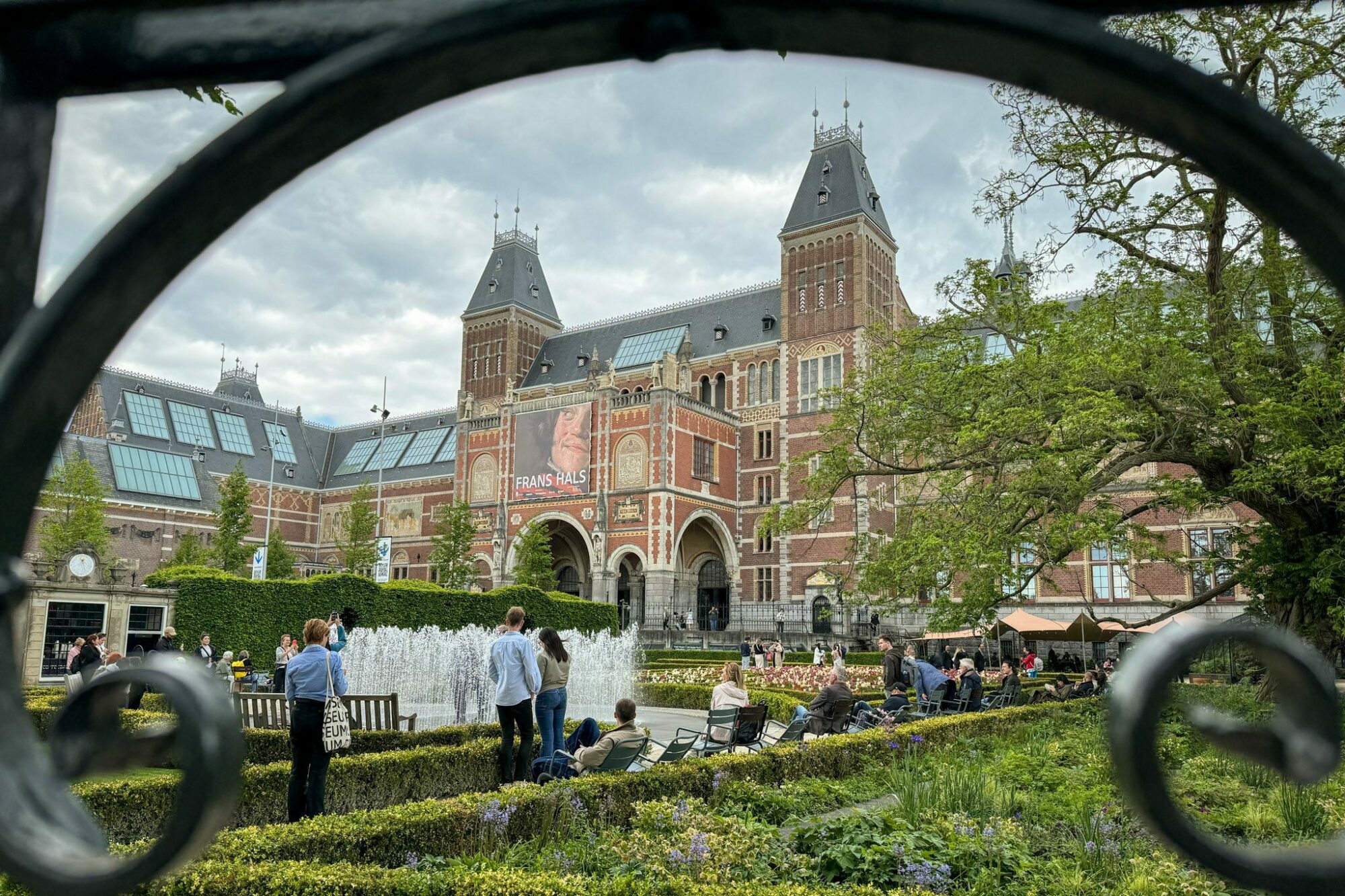
Pros and Cons of Staying near Museumplein
Here are the pros and cons of staying near Museumplein as we see them.
Pros of Staying near Museumplein
It’s convenient for the museums. If you stay here, you’re going to be within a 5-10 minute walk of both the excellent Rijksmuseum and the Van Gogh Museum.
Good walkability. Staying here also means you’re walkable to Vondelpark, De Pijp, and the southern end of the Grachtengordel. It’s very central and easy to get around.
It’s close to Vondelpark. This area puts you right on the edge of Vondelpark, the big city park that runs along Oud-Zuid that is the closest thing Amsterdam has to something like Central Park in New York City or Stanley Park in Vancouver.
Good public transportation connections. Between the trams running in both directions and the bus connection from the airport (bus 397), it’s very very easy to get to and from this part of the city.
Cons of Staying near Museumplein
It’s expensive. As you might imagine given the location, this is a relatively expensive part of the city to stay in. You’re paying for the location, which is excellent.
There’s not much to eat or drink. Now, this is a little bit of a mixed bag because, on the one hand, there isn’t much to eat in the neighborhood itself (it’s a little more chain-heavy than I’d like).
However, it’s also worth noting that you’re so close to Oud-Zuid and De Pijp – two great food neighborhoods – that it barely matters.
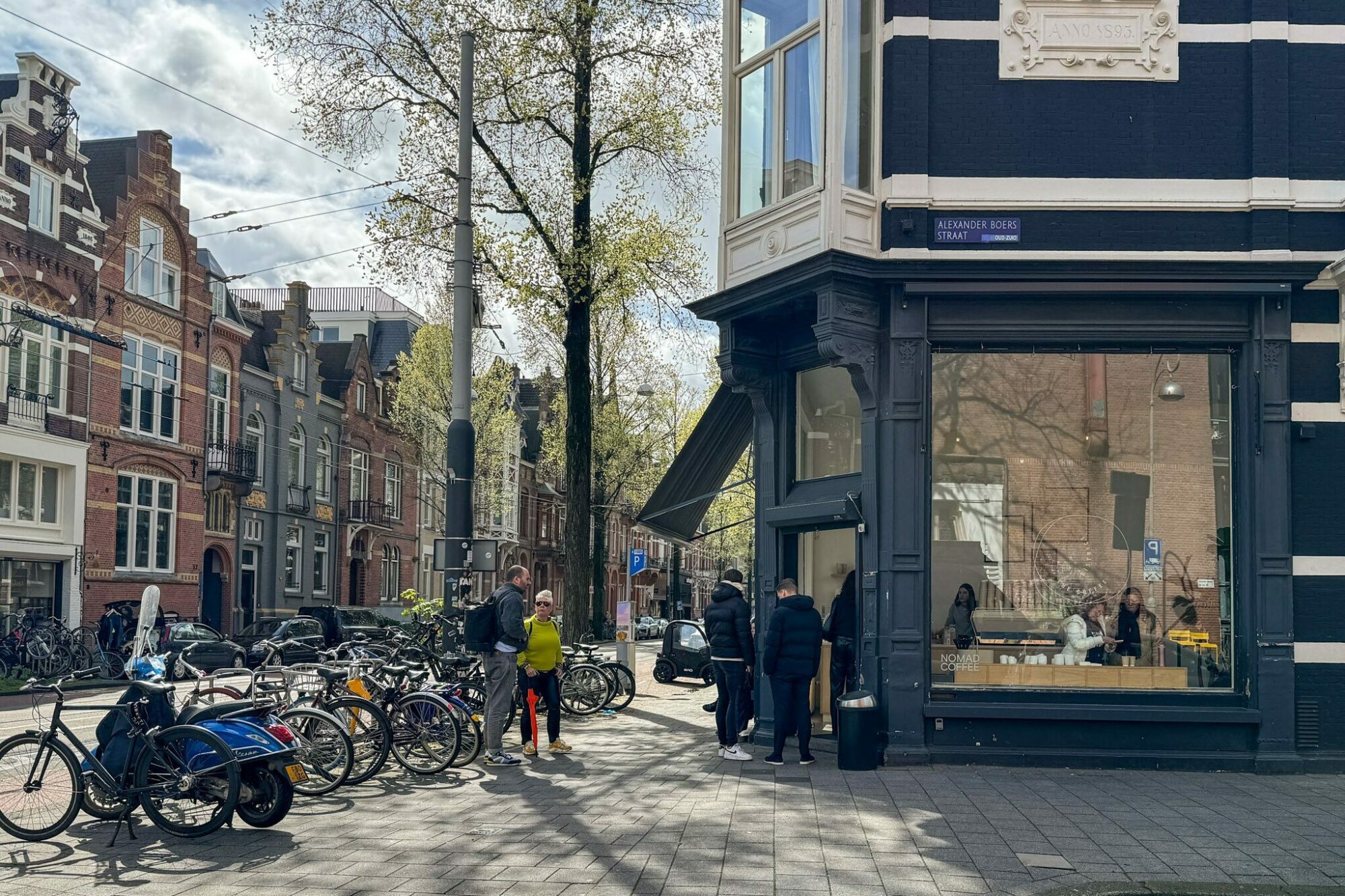

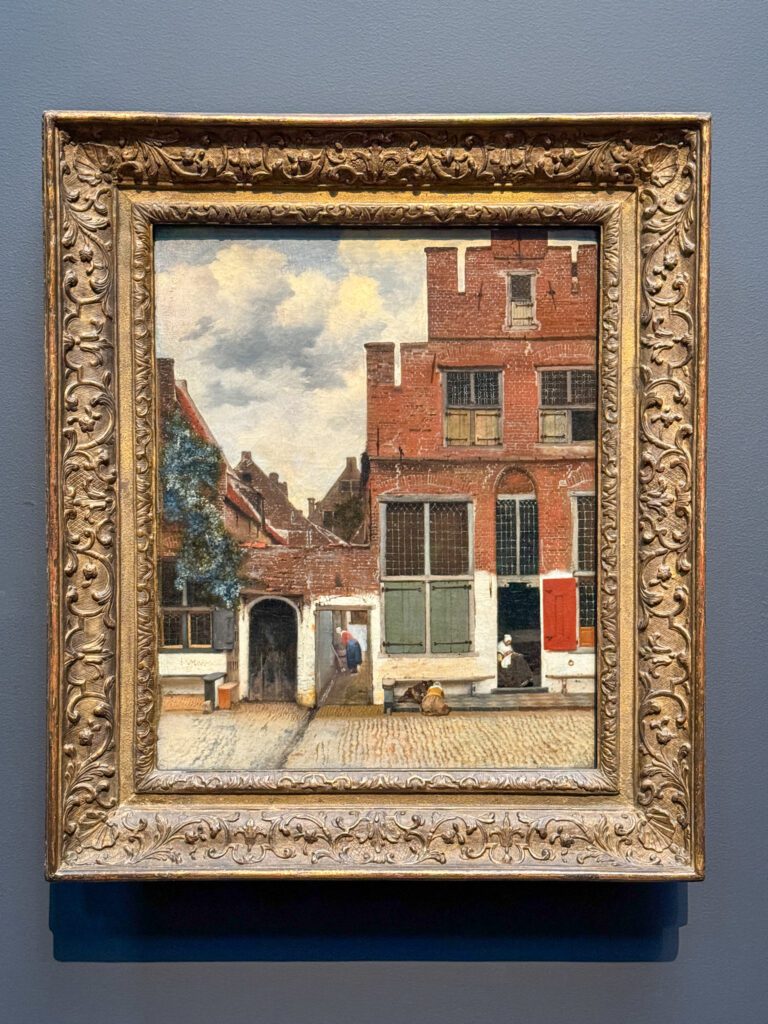
The Best Places to Stay in the Museum Quarter
Here are a few places near Museumplein that caught our eye.
De Ware Jacob Boutique Hotel: A Beautiful Guesthouse
This beautiful boutique hotel was completely renovated in 2020, and is a few blocks southwest of Museumplein (and the associated attractions and tram lines you’ll find there).
It’s also within 10-15 minutes (on foot) of both Vondelpark and De Pijp.
The hotel is relatively small – just 19 rooms here – and rooms range from compact hotel rooms (good for shorter stays, but probably too small for four or five nights) to apartments with kitchenettes and family rooms with multiple beds.
Conscious Hotel Museum Square: An Eco-Friendly Hotel Right on the Square
Conscious Hotels is a chain in Amsterdam, and they have a few locations around the city (including one in Westerpark, which I walked by and stepped into to check it out).
Their whole brand is about making eco-friendly changes to the way traditional hotels are operated (like swapping in water-saving shower heads and LED lights) for a more sustainable hotel.
The Conscious Hotel near Museumplein is less than a block from the south end of the square, which is a great location.
Everything I’ve said so far might make you think that the price is going to be astronomical here, but we would put this hotel firmly in the “mid-range” category.
Nothing about the experience is going to blow your socks off, but it is going to have you feeling like you got a great value.
Rooms are fairly simple and minimalist, with a pretty standard selection of room types, from doubles to their “WOW” rooms, which come with a little more living space and a private terrace.
De Pijp: The Best Blend of Location + Local Vibes
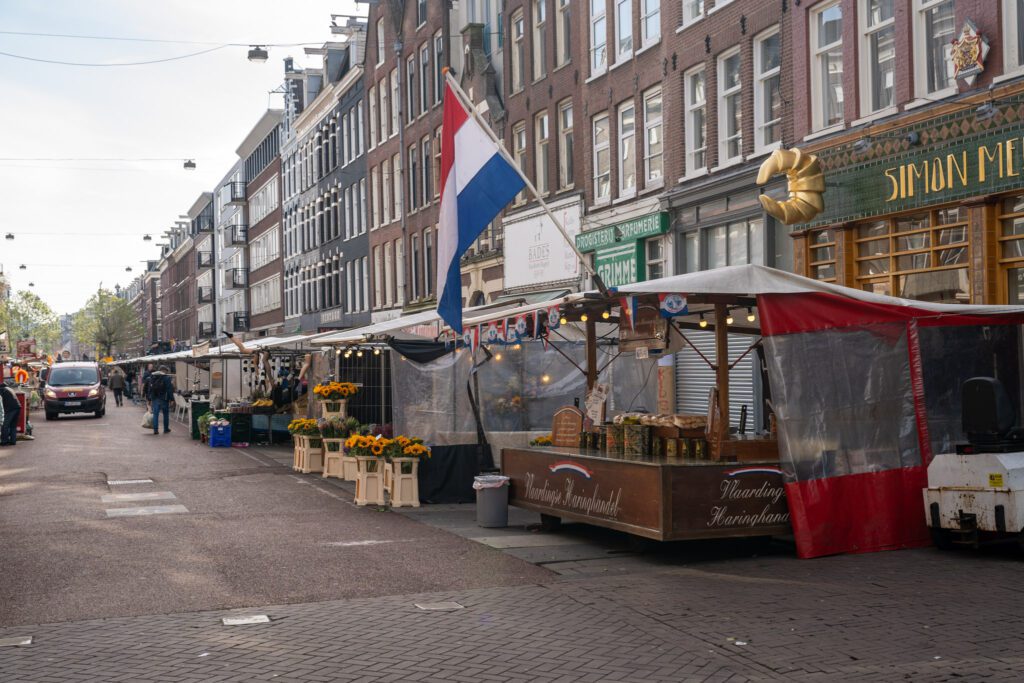
Overall, De Pijp is probably my favorite part of Amsterdam. If I was moving to Amsterdam, it would likely be the first place I’d look to live.
After my first trip to Amsterdam, I viewed De Pijp as the place where the Albert Cuyp Market is, and didn’t think much beyond that. Yes, the Albert Cuyp Market is great, and is well worth a visit. But there’s A LOT more to De Pijp than that one delicious street.
I happened to be staying a few blocks east of De Pijp for part of my trip, and ended up spending a good amount of time walking through the neighborhood over the course of a week of exploring Amsterdam.
Essentially, De Pijp is a little manmade island just outside of the Singelgracht (one of the canals that makes up the Grachtengordel) that is adjacent to Museumplein.
Within that island, you basically have everything you need in terms of living; great food and drinks (see “highlights” below for my favorites), multiple nice shopping stretches (I particularly enjoyed Ceintuurbaan and Van Woustraat), and an unexpected park in Sarphatipark.
However, as far as whether or not it makes sense to stay here as a tourist goes, it suffers from one major drawback; it’s very residential with very few places to stay (which is most of the reason why it feels like such a local vibe).
There are a few nice places to stay along the edges of De Pijp just across the canal – like the Volkshotel and the Social Hub Amsterdam, but you’ll be sacrificing the atmosphere of actually staying in De Pijp (which may or may not matter to you at all).
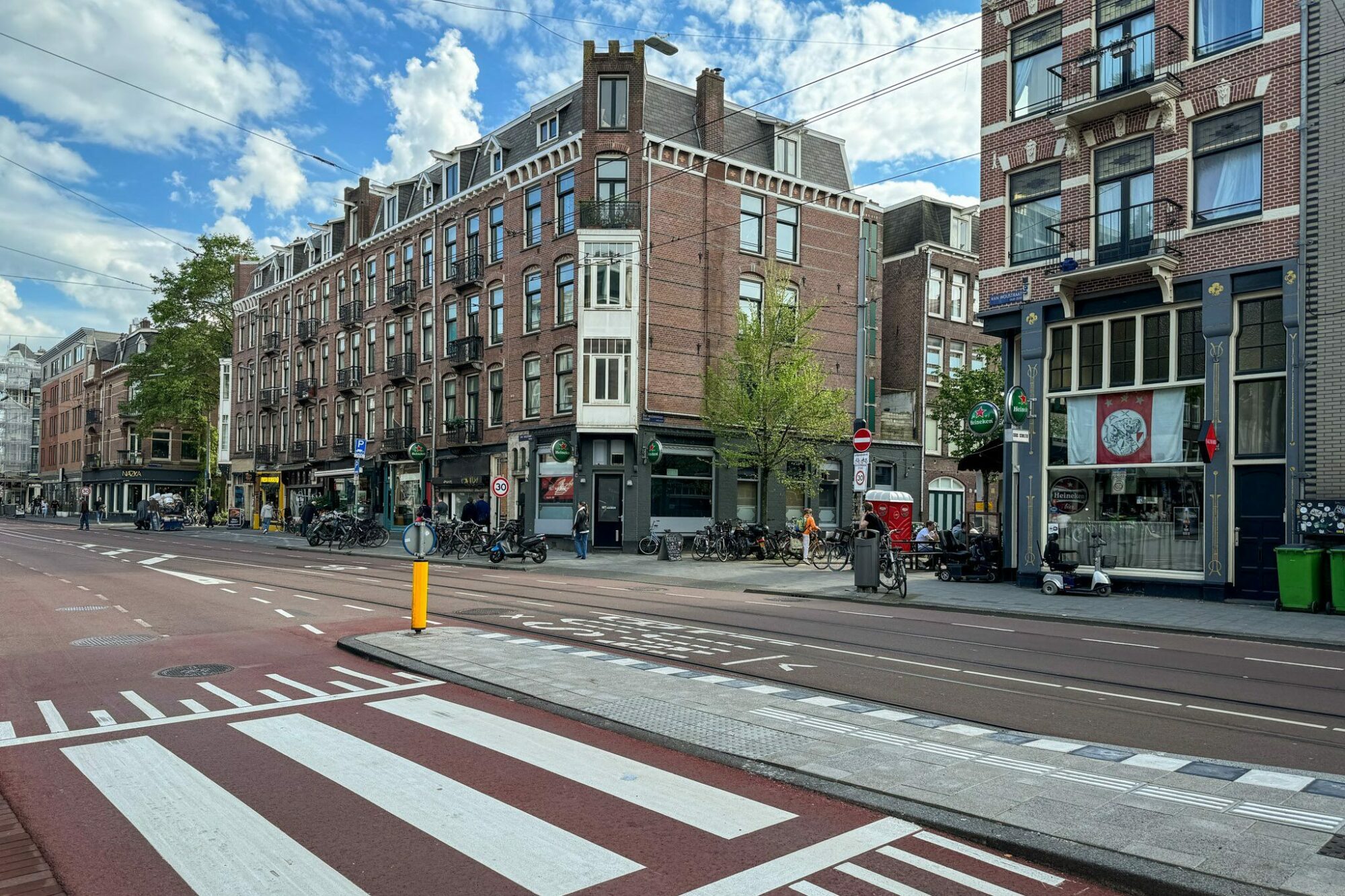
Pros and Cons of Staying in De Pijp
Here are the pros and cons of staying in De Pijp as we see them.
Pros of Staying in De Pijp
Real Amsterdammers live here. This is, by far, our favorite thing about De Pijp. As you’re walking around the canal belt, you’ll notice that it really feels like you’re completely surrounded by tourists.
Which is fine, but it makes you wonder where all the residents are. They’re in De Pijp (and other areas like it)!
It’s walkable. Aside from having everything in De Pijp right outside your front door, you’ll also be able to walk to Museumplein, Vondelpark, and the canals.
It’s centrally located, and the places you can’t walk to are easily accessible with the tram and metro stops in the neighborhood too.
It’s charming. Between the brick buildings (we don’t get a whole lot of those on the west coast) and green spaces, it’s all charm, charm charm in De Pijp.
Tons of great places to eat and drink. There are a multitude of great places to eat and drink in the neighborhood (you can find a small selection of them down below in the highlights section). You could eat every meal here and never run out of great places to eat!
Cons of Staying in De Pijp
The hotel selection. This is directly related to the first bullet above, and we don’t necessarily think this is a bad thing at all.
The fact that this is such a residential area populated by Amsterdammers means that, unfortunately, there really aren’t a whole lot of options in terms of places to stay.
There are, however, some nice hotels around the edges of the neighborhood just across a canal or the Amstel River, like the CitizenM Amstel (we love CitizenM and have stayed at 4+ of their hotels around the world) and the family owned and operated Hotel Asterisk.
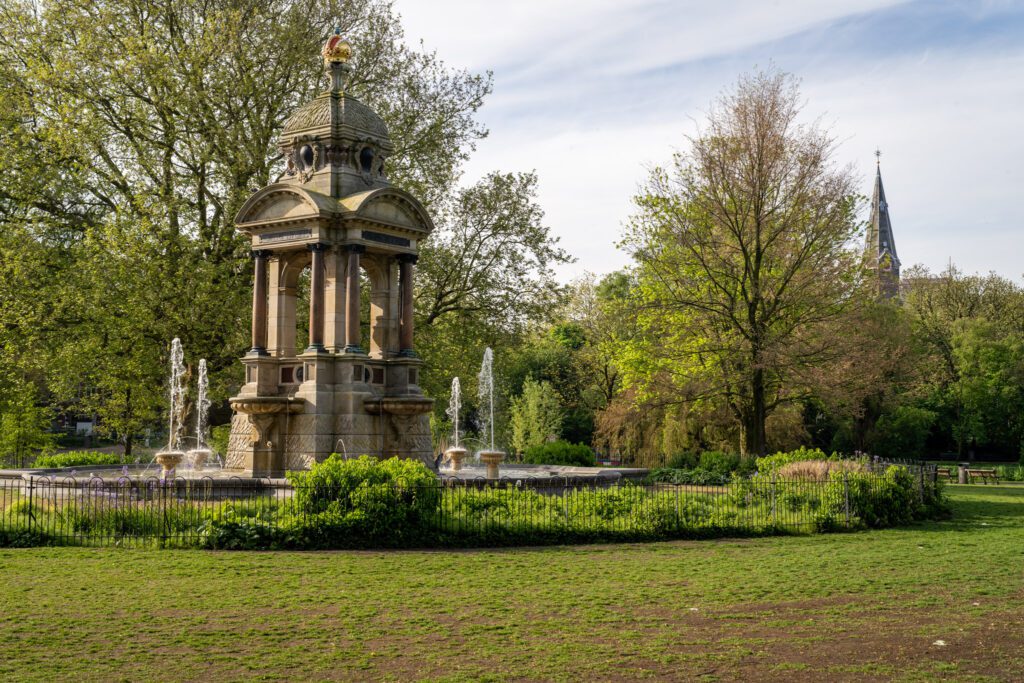

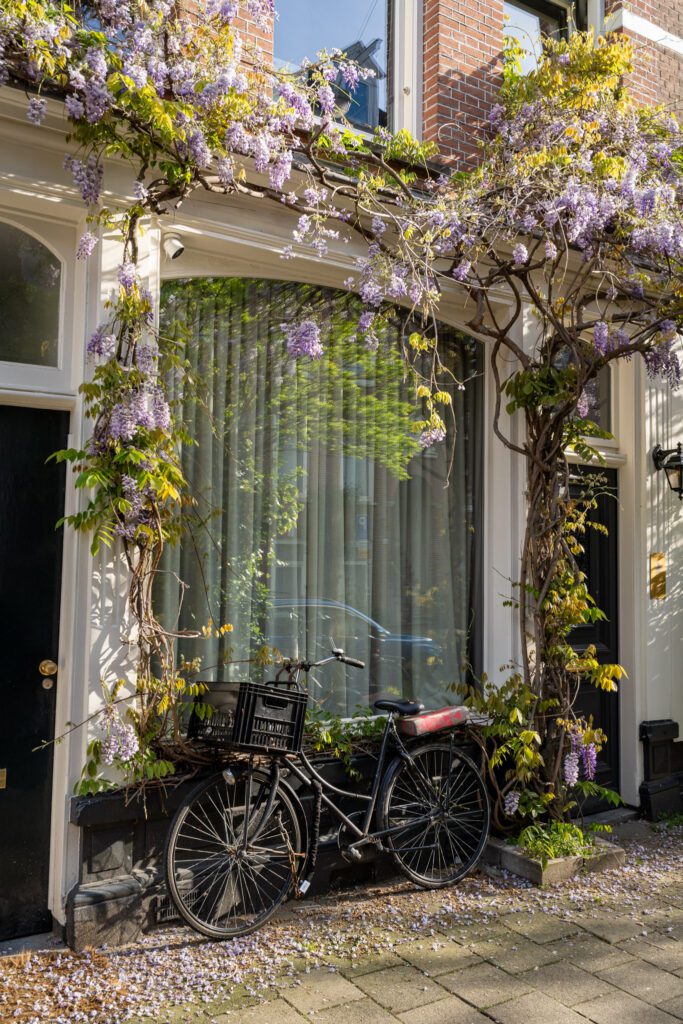
The Best Places to Stay in De Pijp
Here are a few places to stay in (and within a few blocks of) De Pijp.
CitizenM Amsterdam Amstel: A Modern, Mid-Range Hotel
We love CitizenM Hotels, which are consistently one of our favorite hotel chains in the world (source: we’ve stayed in four of their hotels around the world in the past couple of years).
They’re a Dutch hotel chain that has basically made staying in a hotel super easy and streamlined, with all the amenities that modern, younger travelers are looking for (USB charging, climate controls via iPad, and more) while simultaneously stripping out the unnecessary pieces (fluffy robes and slippers or sitting areas, for example) to offer a great value.
The location of their hotel in the Amsterdam City Center is great, though it’s technically just across the canal from the border of De Pijp.
We’re still including it, because close enough, right? It’s a 15 minute walk to Museum Square, and a 20 minute tram ride from Amsterdam Centraal (or a 30 minute walk).
Each room comes with all the amenities we’re looking for – blackout blinds, showers with good water pressure (which we’ve found is fairly uncommon, at least in Spain, Portugal, and Italy, where we spent a lot of time recently).
Another modern touch is that you can control the lights, climate, and blinds with either a tablet in the room, or an app on your phone.
Hotel Notting Hill: Nice Boutique Hotel in De Pijp
Just across the canal to the north of De Pijp (which I think means it’s not technically in De Pijp, but is literally a block outside of the border), this boutique hotel is a stylish, mid-range option.
Rooms are fairly spacious, starting at 180 square feet (22 square meters) and going up from there.
Some rooms are underground, which might be kind of dingy and depressing, but those rooms are also the cheapest of the bunch, so if you’re on a budget, they might be a good option. Some rooms also have canal views!
Since it’s on the northern end of the neighborhood, that means that you’re a few minutes closer to the action in Central Amsterdam, and tram #4 stops literally right outside the hotel, which gets you to Amsterdam Centraal in 15 minutes flat.
Oost / Plantage: A Low Key Option for Longer Stays
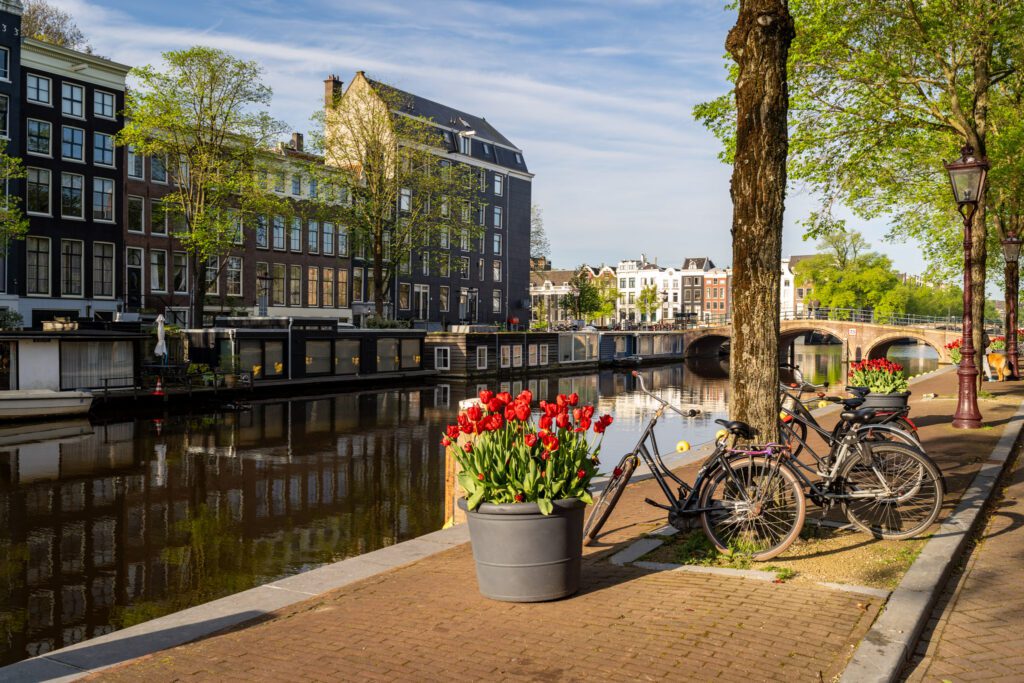
This is another situation where I’m giving you two areas, one of which is a bigger area, and one of which is a specific neighborhood within that broader area.
In this case, Oost is the broader area, and refers to the whole area to the immediate east of the city center and the Amstel River.
It technically covers the entire area out to the east until the River IJ turns into a lake, but we’re mostly talking about the innermost piece of that area.
Plantage is a small sliver of that broader neighborhood that takes up the area near the ARTIS Zoo and the historic Jewish Quarter in Amsterdam (if you’re interested in going beyond Anne Frank to learn about the Jewish history in Amsterdam, I did this walking tour and loved it).
This chunk of the city is green and leafy, with beautiful residential buildings lining its streets.
The rest of the western part of Oost is also pleasant, and it very much feels like people actually live in this part of the city. Further south, the area around Oosterpark is also very nice, and that park is one of my favorites in Amsterdam.
I stayed in Oost for the majority of my latest trip to Amsterdam, and found it to be a very pleasant, quieter, and relatively affordable area to stay.
With the tram routes running from Oost across the city through De Pijp and Museumplein, and other routes running to Dam Square and Amsterdam Centraal, you’re also well connected to the rest of the city (although it’s not as easy to get to and from the airport from here – it requires a transfer or a taxi).
But if you’re looking for a low key home base with good connections to the rest of the city, nice green spaces within the neighborhood, and a good selection of hotels, this is a great choice (especially for trips of 3-4 days or more, where the proximity to the main attractions isn’t as essential).
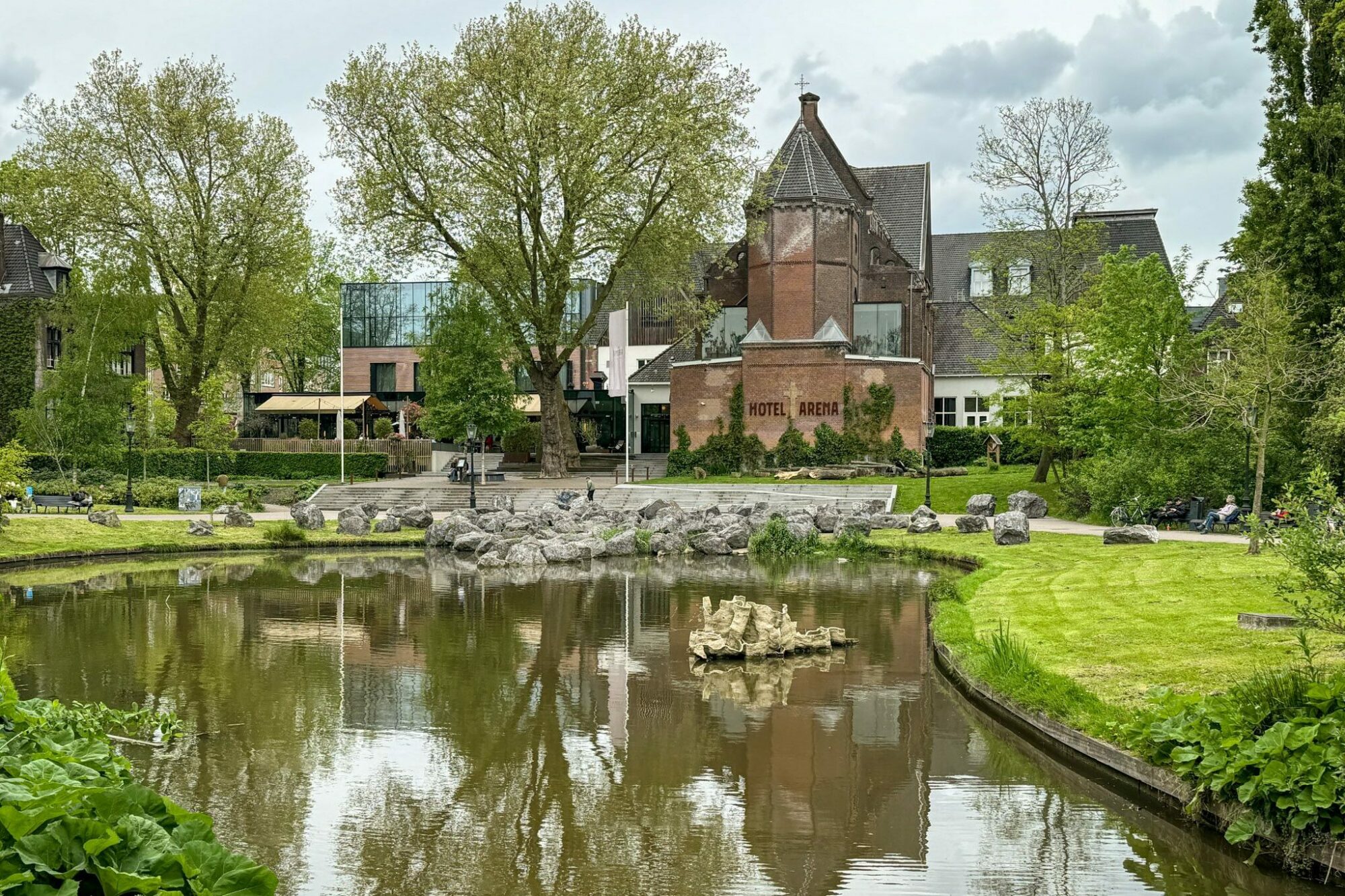
Pros and Cons of Staying in Oost / Plantage
Here are the pros and cons of staying in the eastern end of Amsterdam as we see them.
Pros of Staying in Oost / Plantage
Great green spaces. If you’re here during the summer, and one of the things that sounds like your ideal day on vacation is sitting in a park with a book and a beer doing some good people watching, this is your spot!
Between Oosterpark and some of the smaller green spaces throughout the neighborhood, there are plenty of spots to plop down and soak up the (rare) sun.
Solid public transit connections. Between the metro station at Weesperplein, the tram lines running east/west along Sarphatistraat, and the lines running towards Dam Square along Plantage Middenlaan, you can get anywhere within 15-20 minutes.
Walkability to De Pijp. From the inner part of Oost (and Plantage), it’s only 10 minutes or so to the heart of De Pijp, which I love as a neighborhood. De Pijp has the best food and drinks in Amsterdam, I’d say.
Cons of Staying in Oost / Plantage
Walkability to the Center. I did it multiple times, but it’s a long walk from here to the center (like to the Jordaan or Dam Square).
What I would do is hop on the tram to Dam Square and walk from there, which is only a ~15-20 minute journey door-to-door.
Airport connections. I couldn’t find an easy way to get from the airport to here without making a transfer on public transportation. Bus 397 serves most of the inner areas on the western side of the city center, but there’s no equivalent (that I found) on the eastern end of the city.
It just means a less convenient, slightly longer journey on public transportation, or a taxi/Uber from the airport (which isn’t particularly expensive if you have a group since Schiphol is relatively close to the city center).
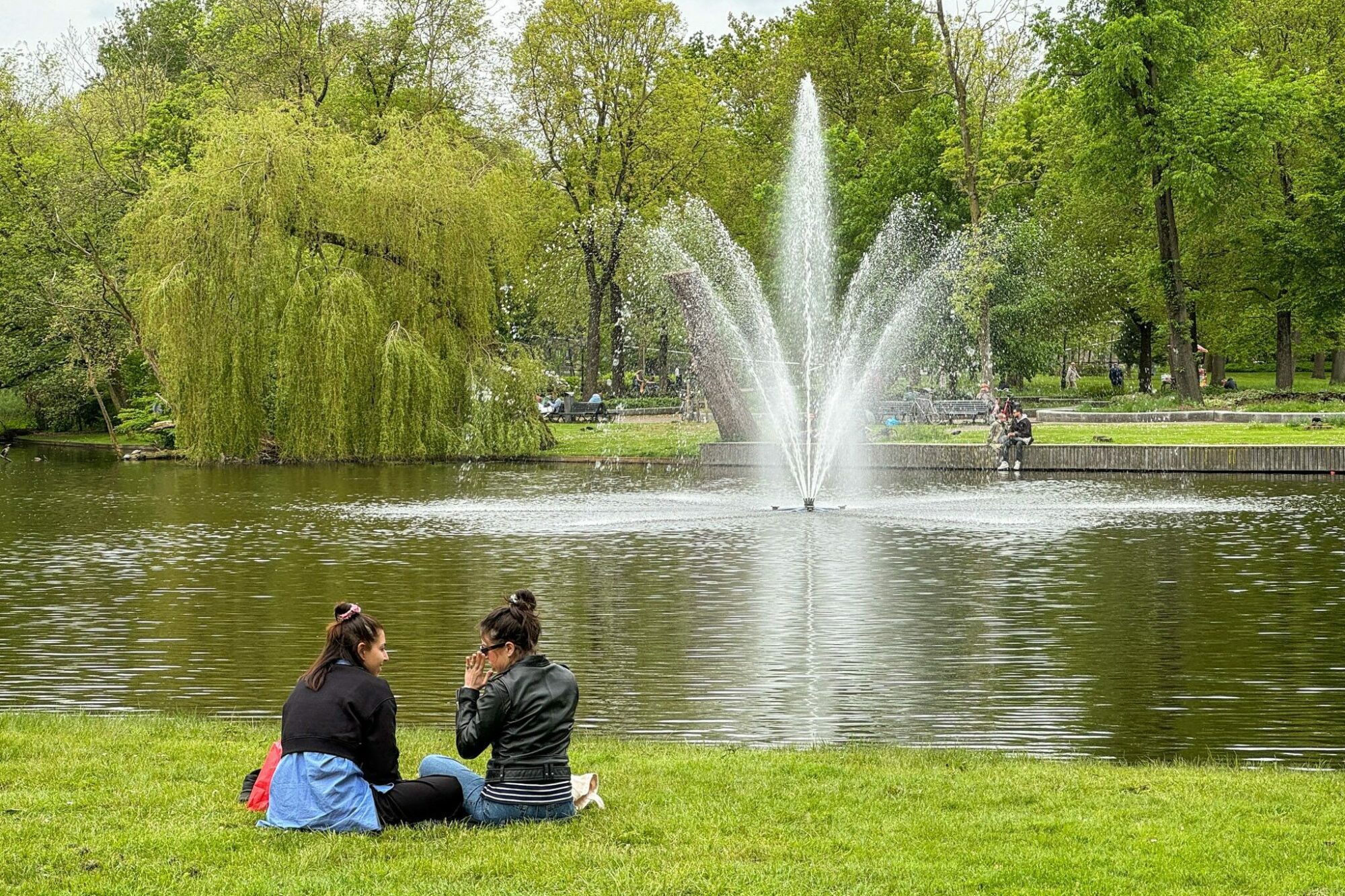
More Amsterdam Travel Guides
Planning a trip to Amsterdam? We’ve been to Amsterdam multiple times over the past few years (including a longer two week spring trip to Amsterdam).
That time spent allowed us to dive deeper into Amsterdam’s unique history and cultural elements that most people miss, like how the mercantilism in early Amsterdam influences the food scene today.
As you get into planning your trip, you might find some of these other detailed guides we’ve written about Amsterdam helpful.

Really enjoyed this guide, very well set out with easy access to hotel details. Love the map with the different areas, and the very helpful descriptions of pros and cons of each area.
Thank you VERY much! Amsterdam was getting too confusing before I found this, but now I will definitely be basing my bookings on your recommendations.
Thanks for the kind words, Helen! We do our best to make things digestible – glad it worked for you. Hope you have an incredible trip to Amsterdam!
Cheers,
Matt